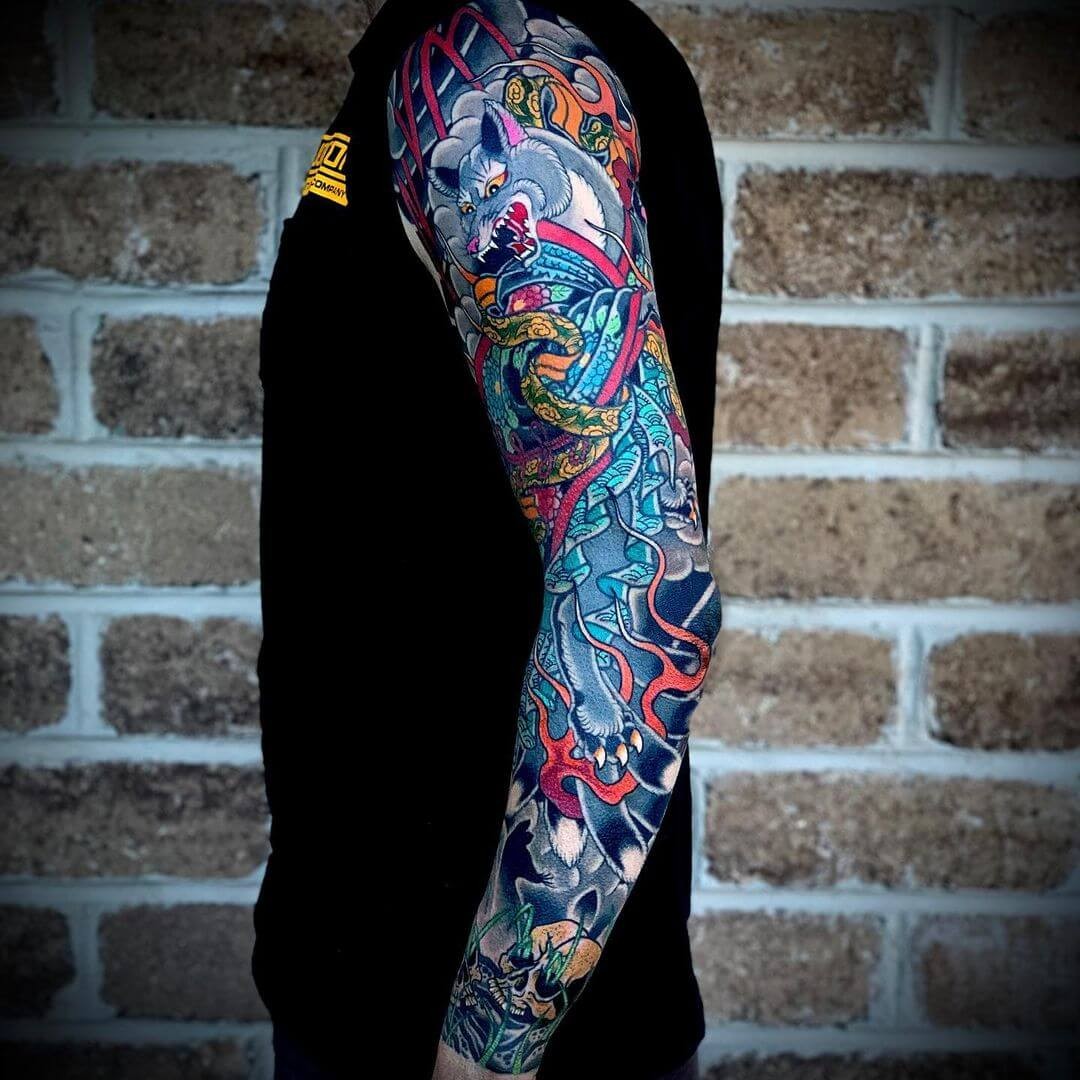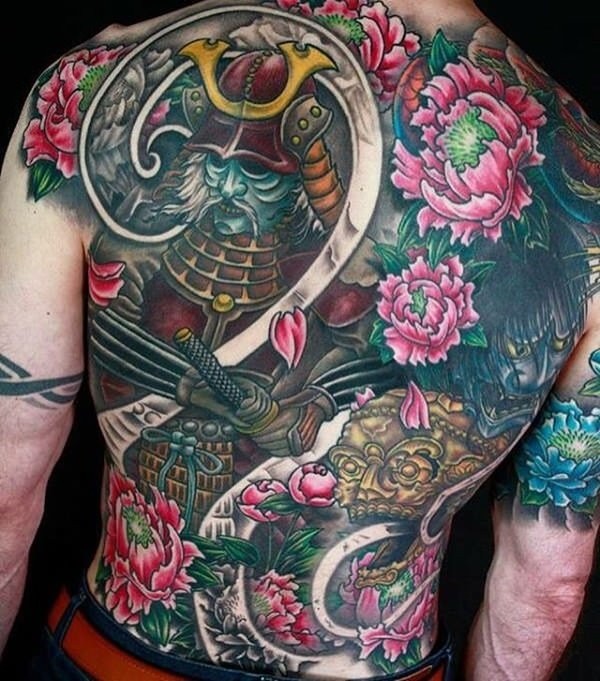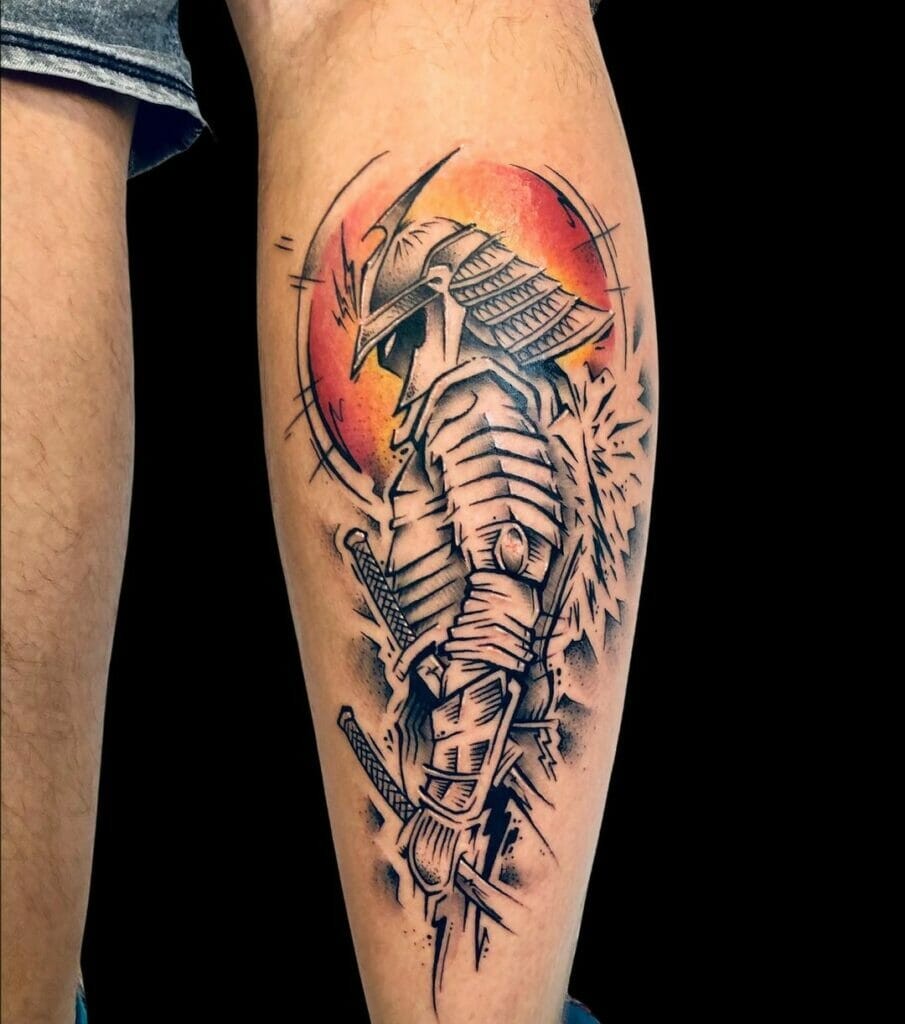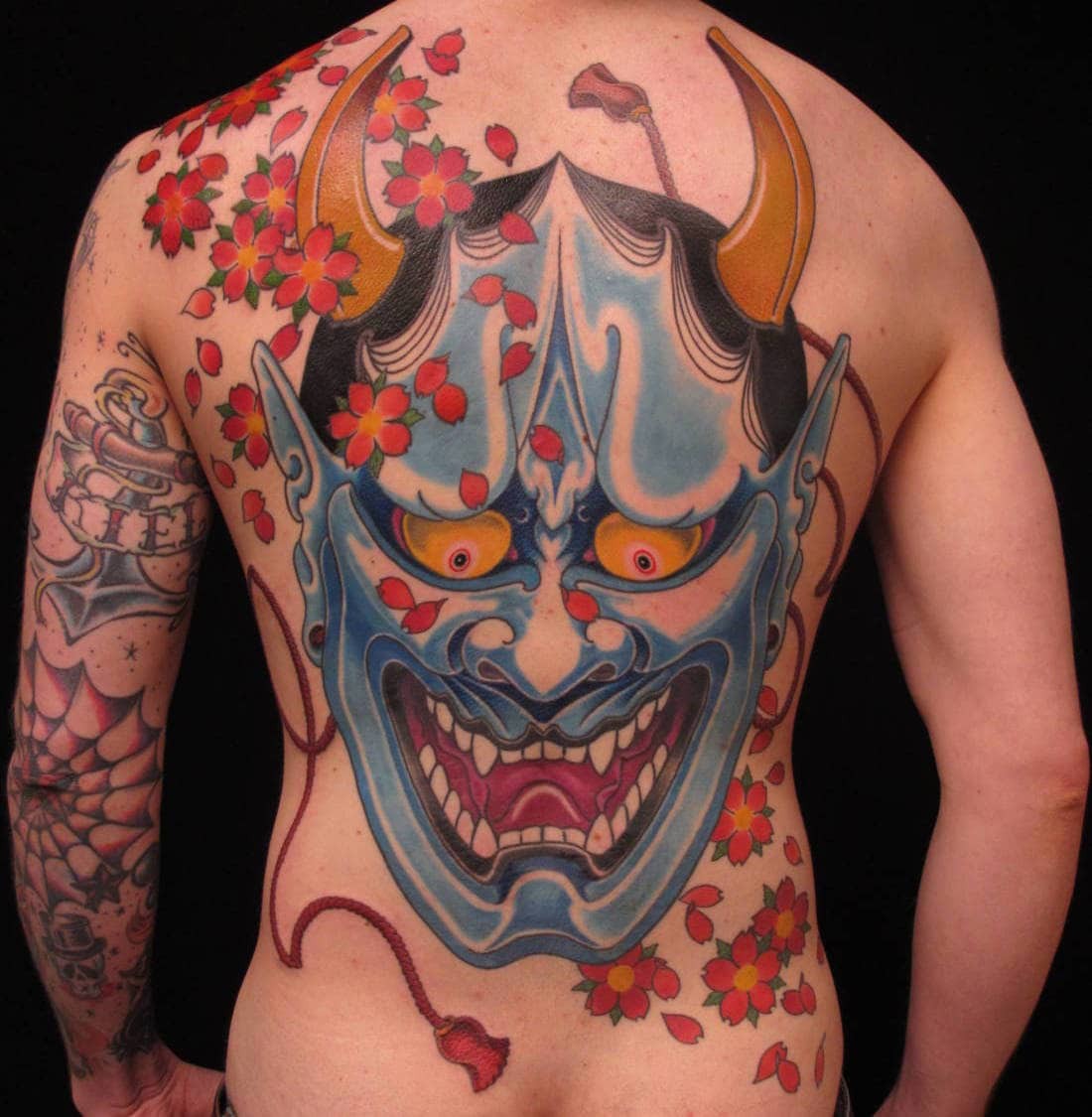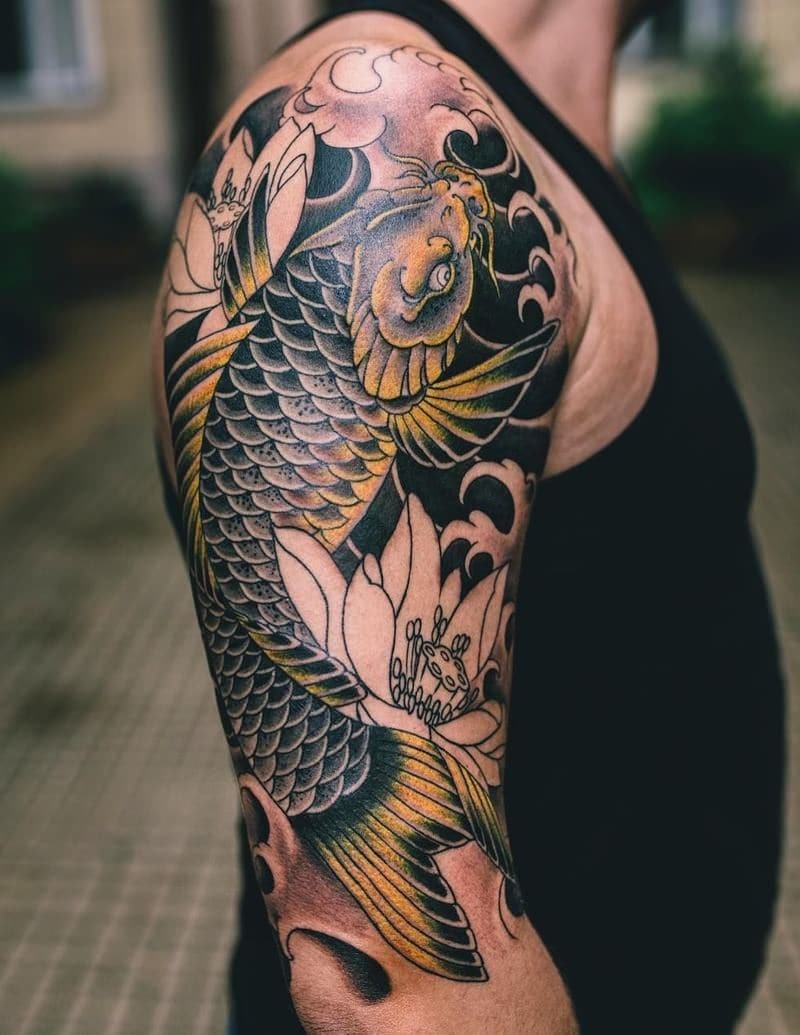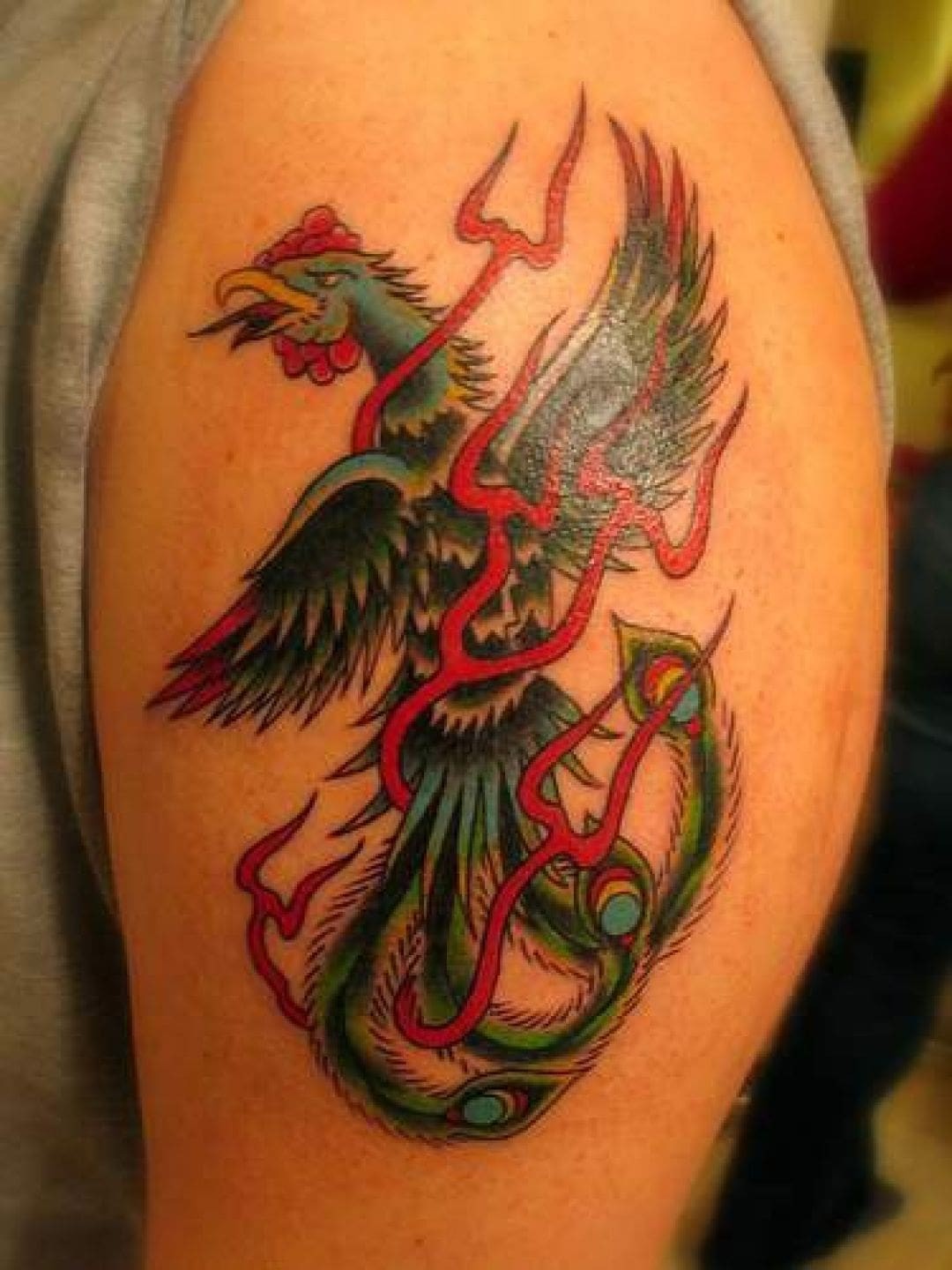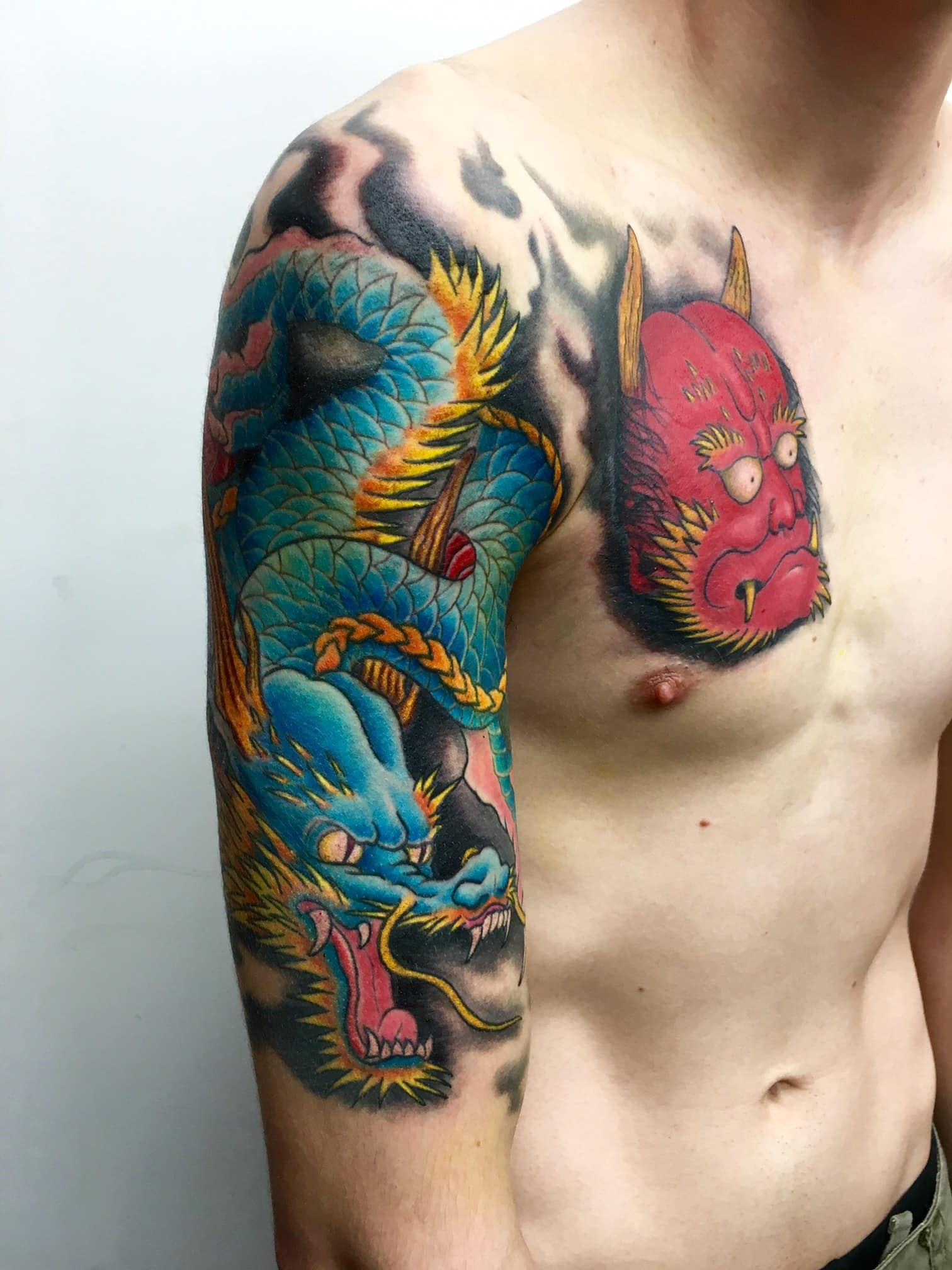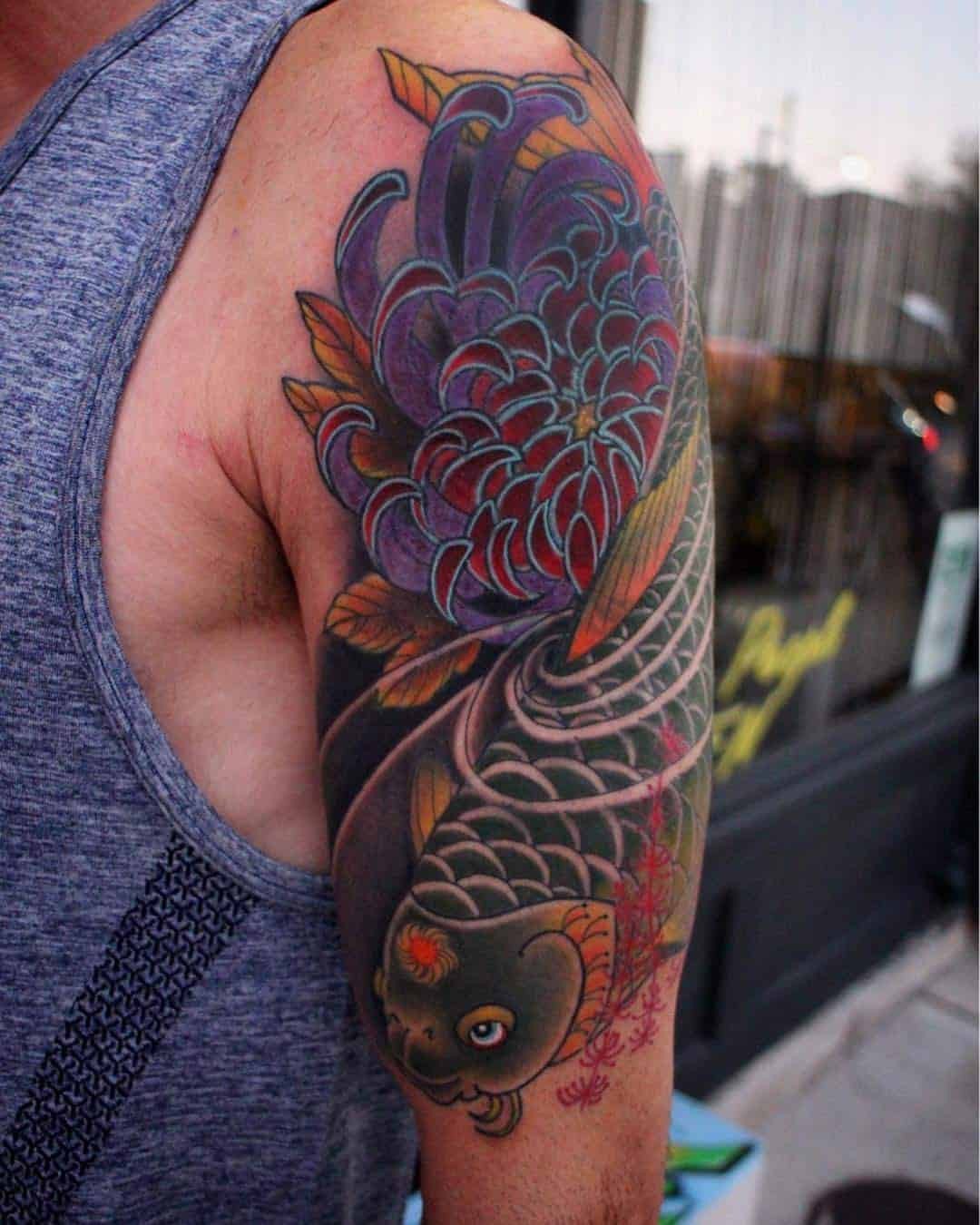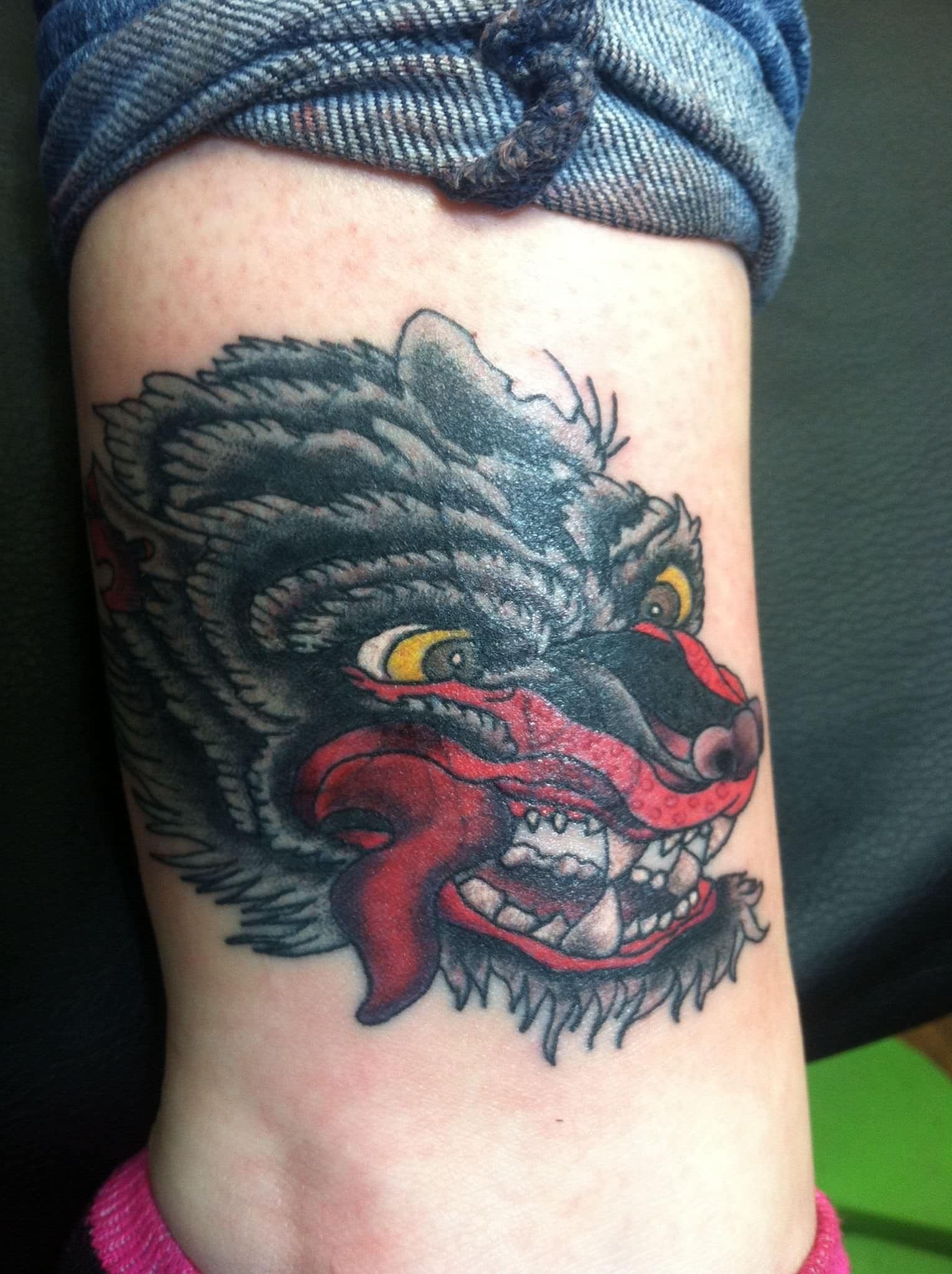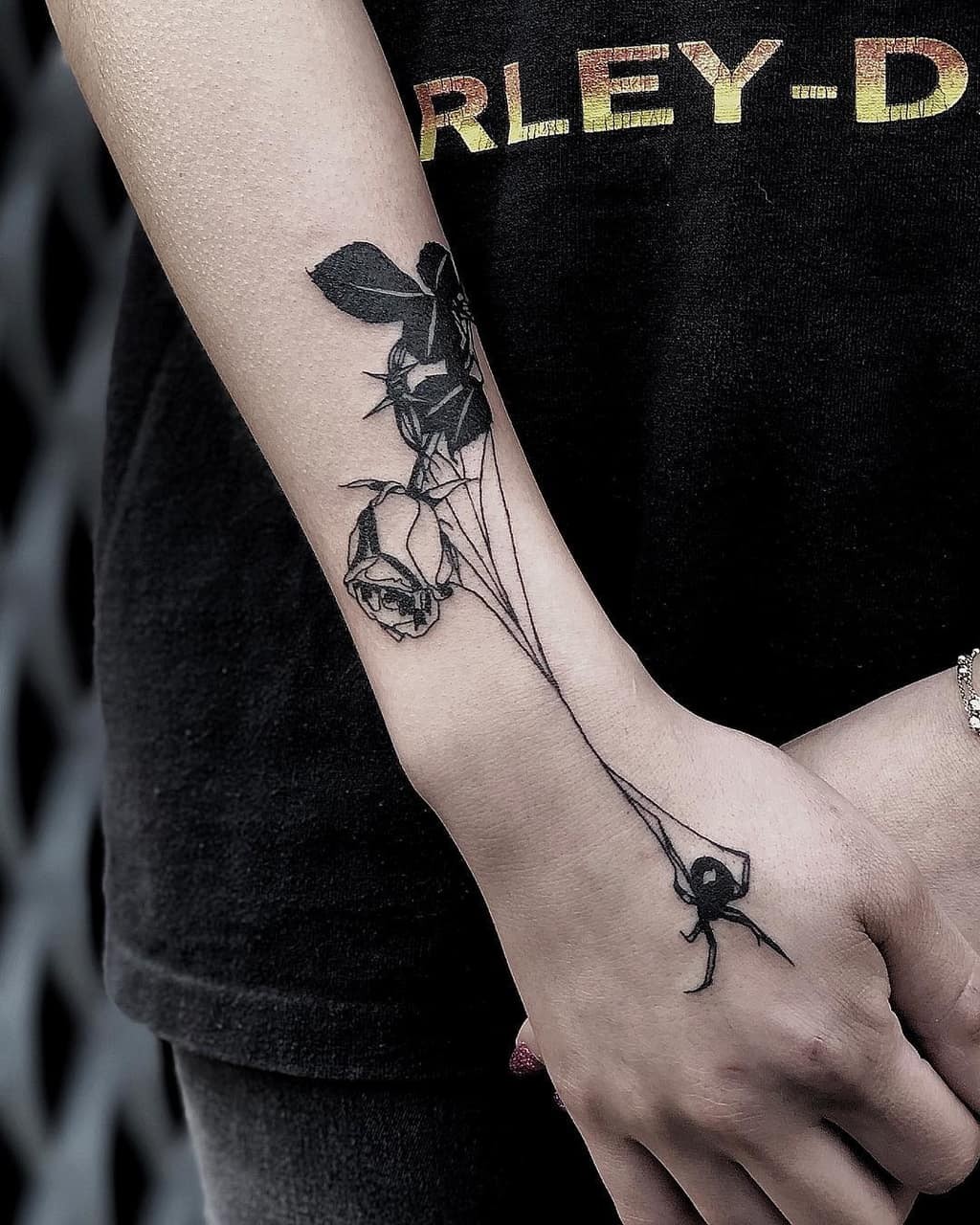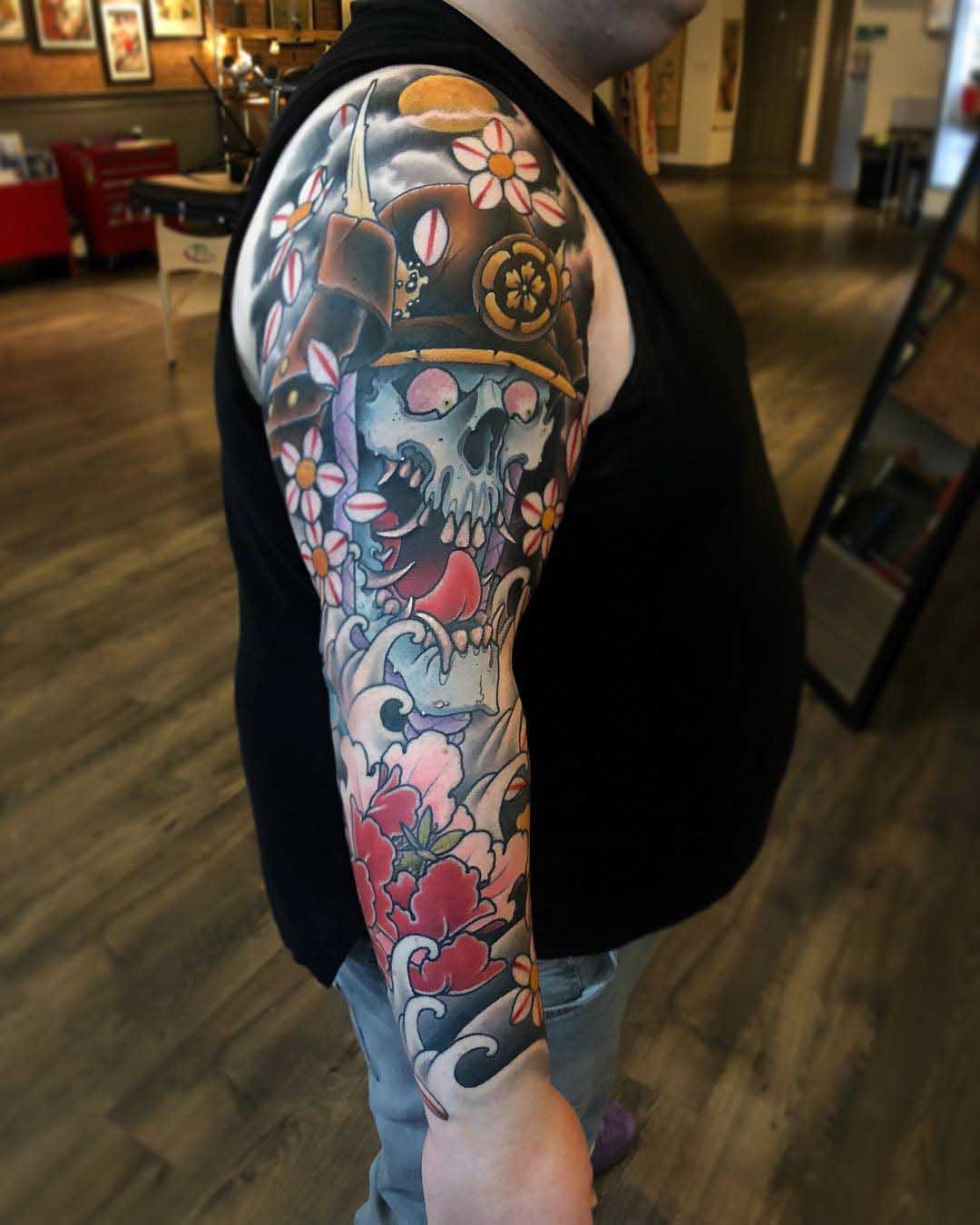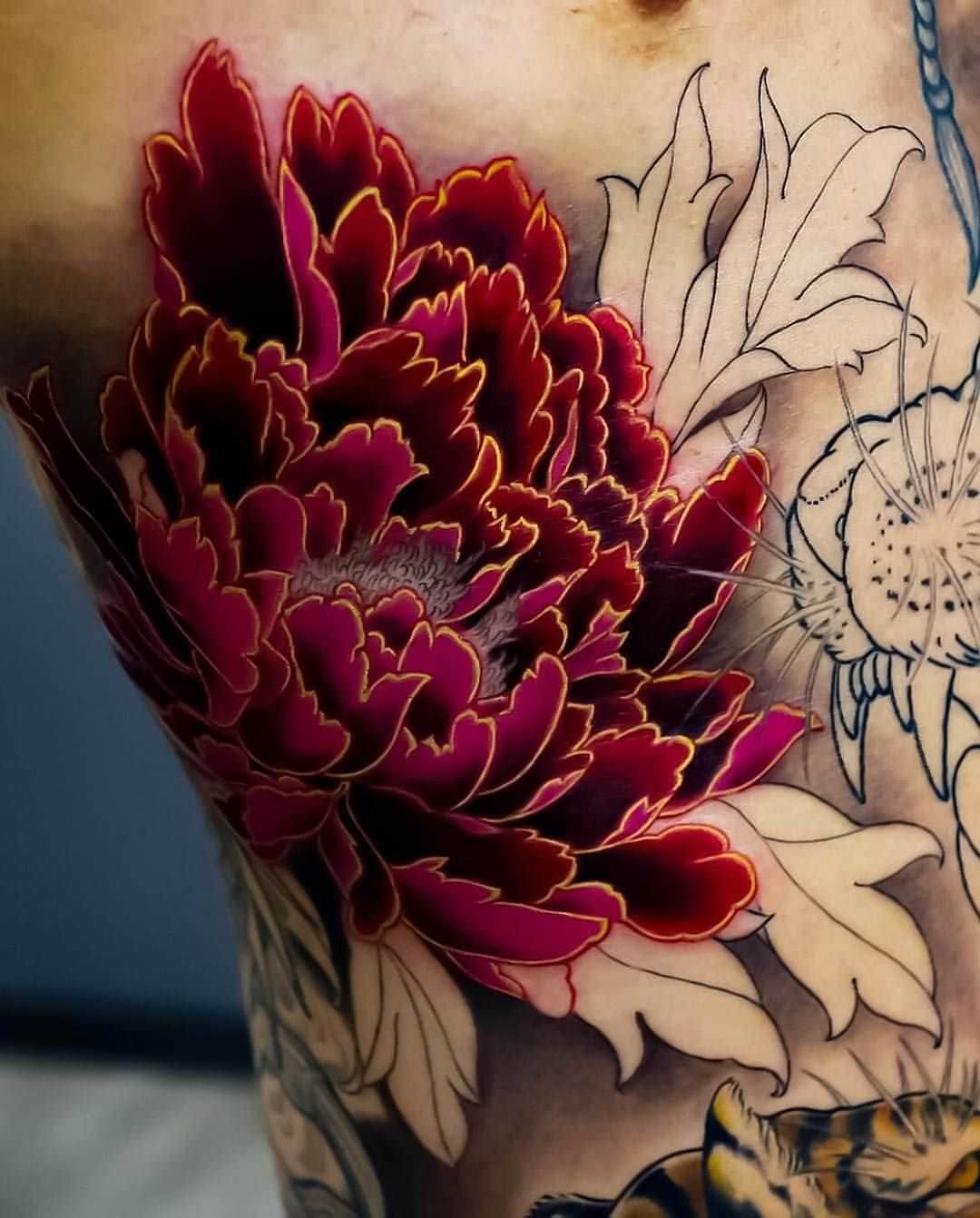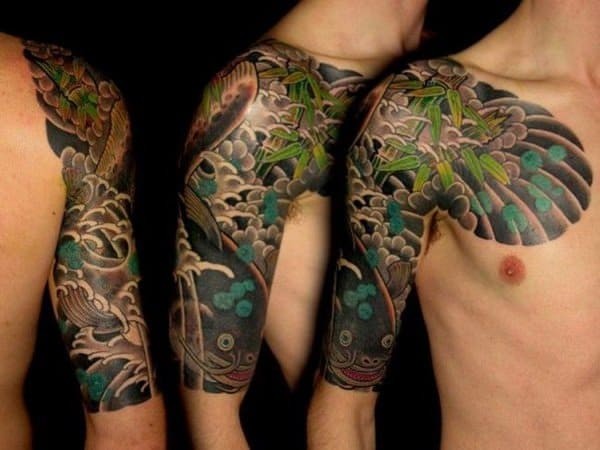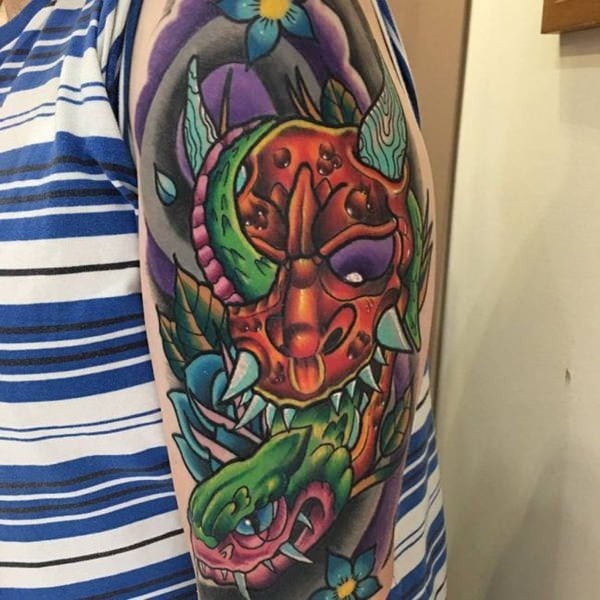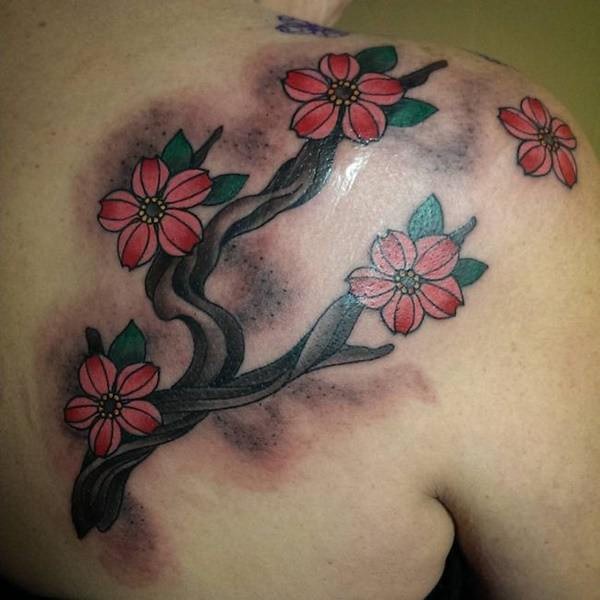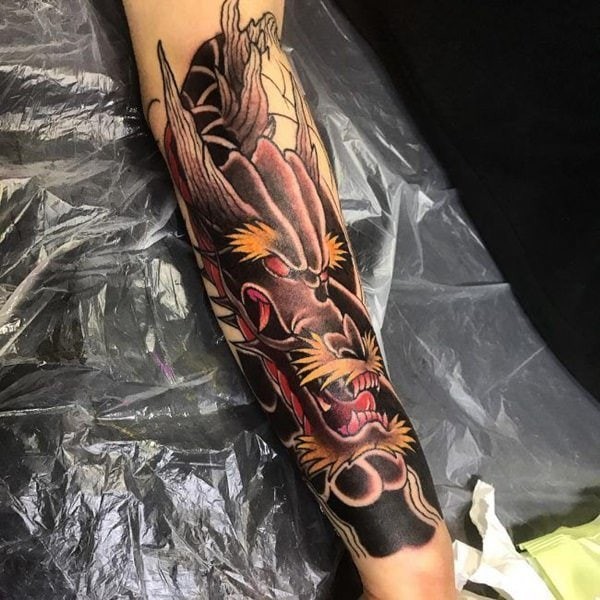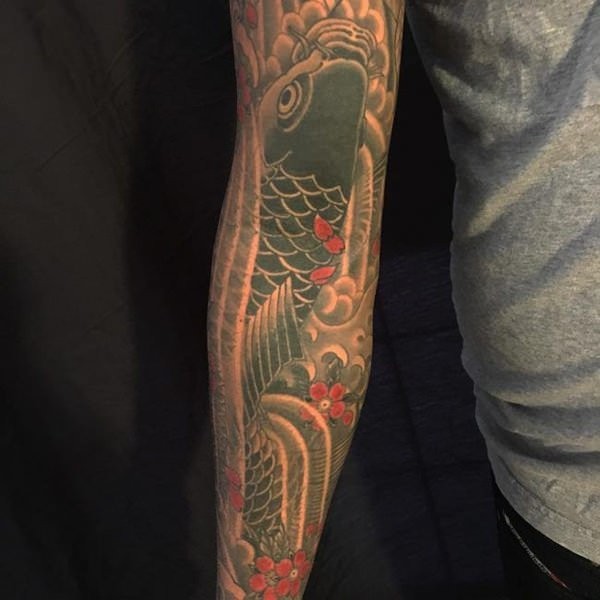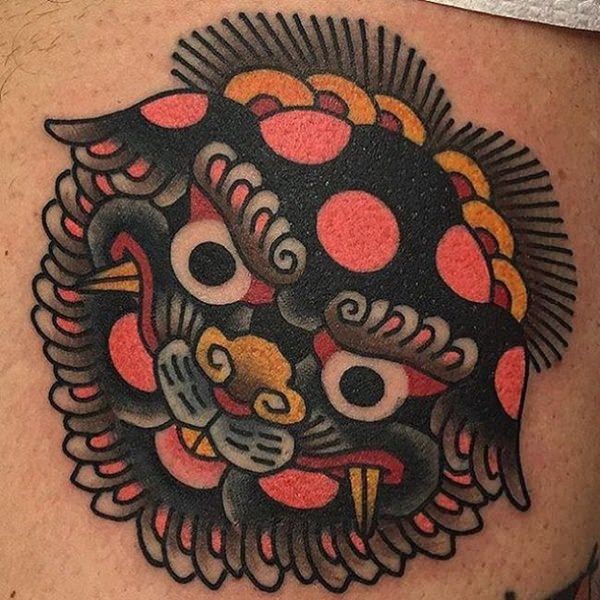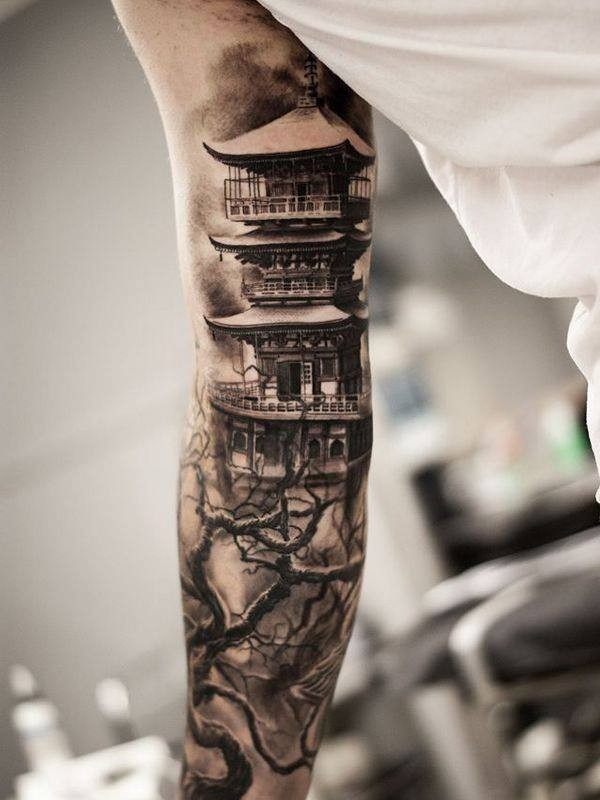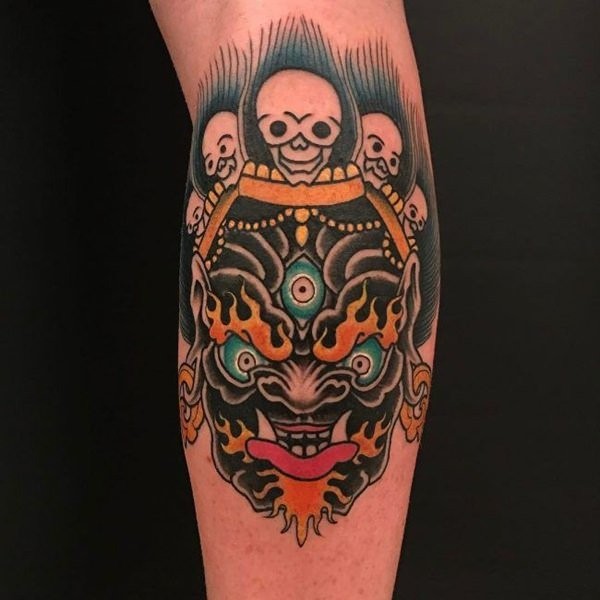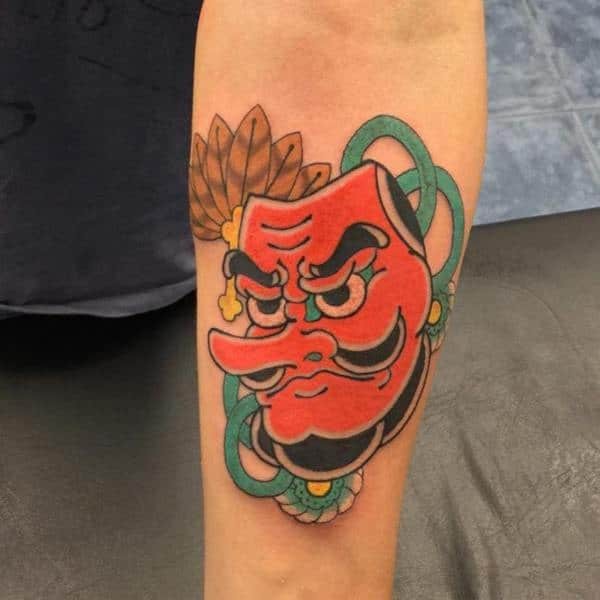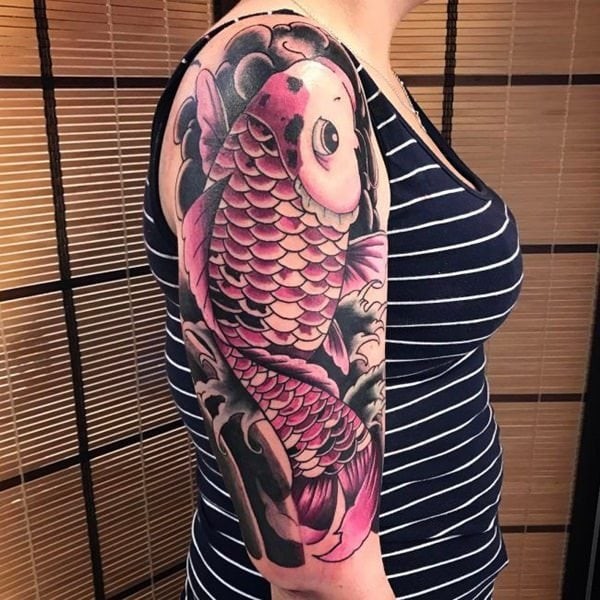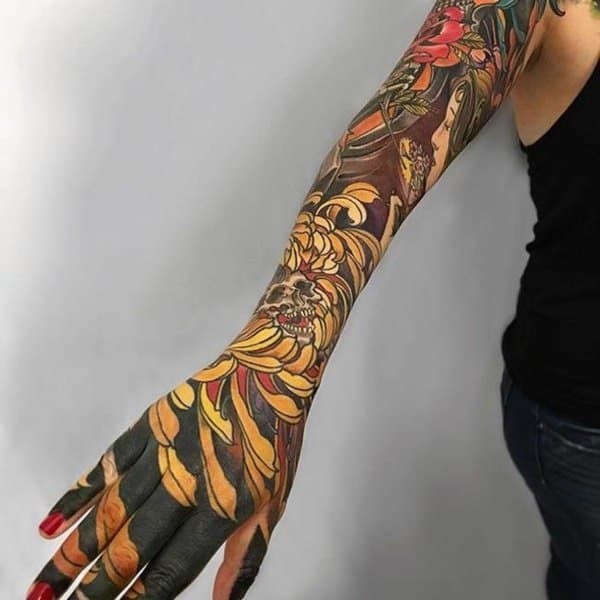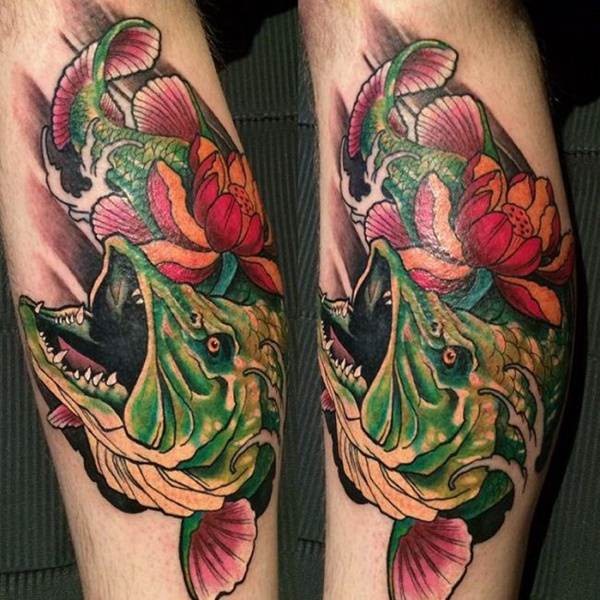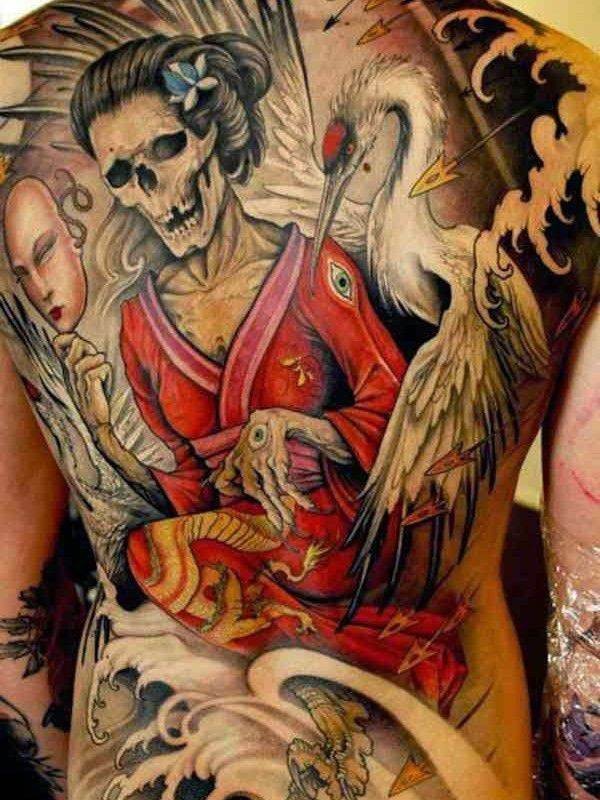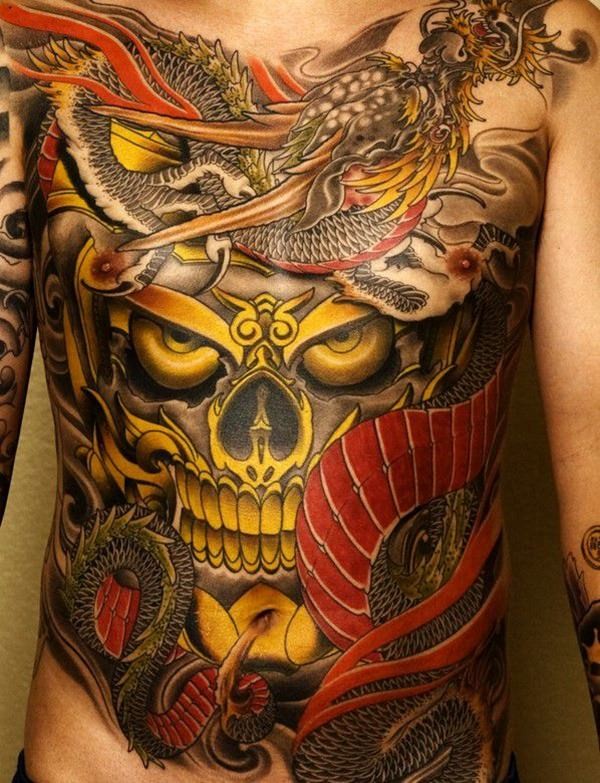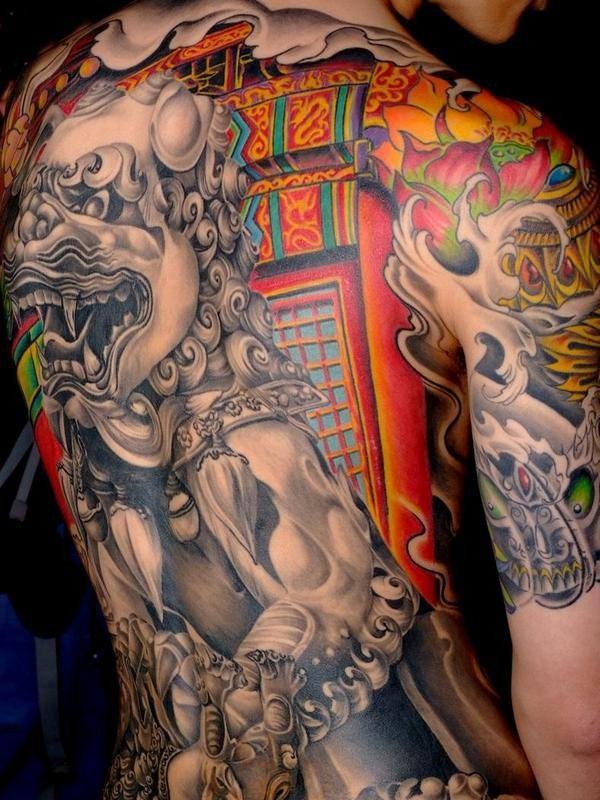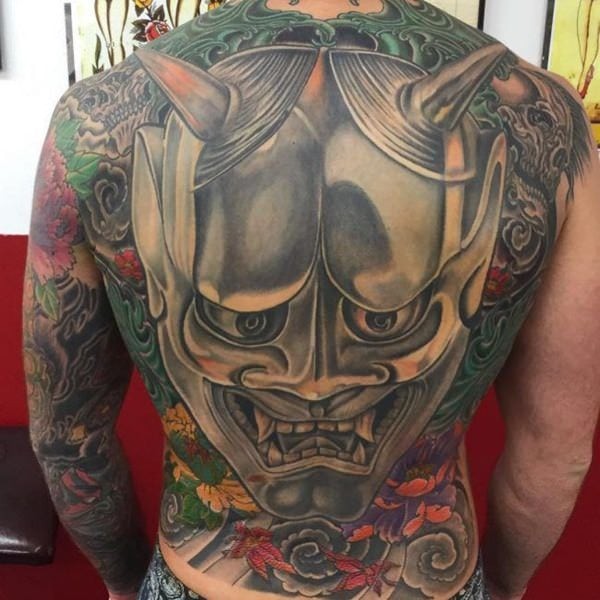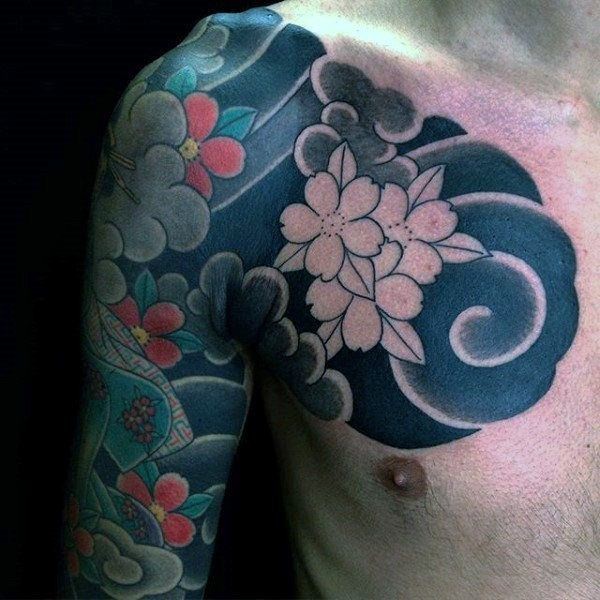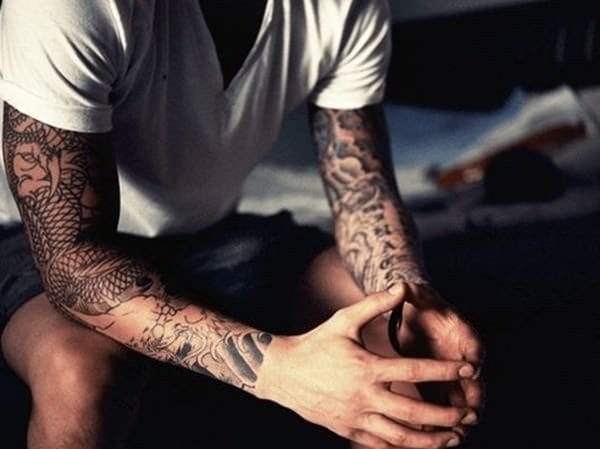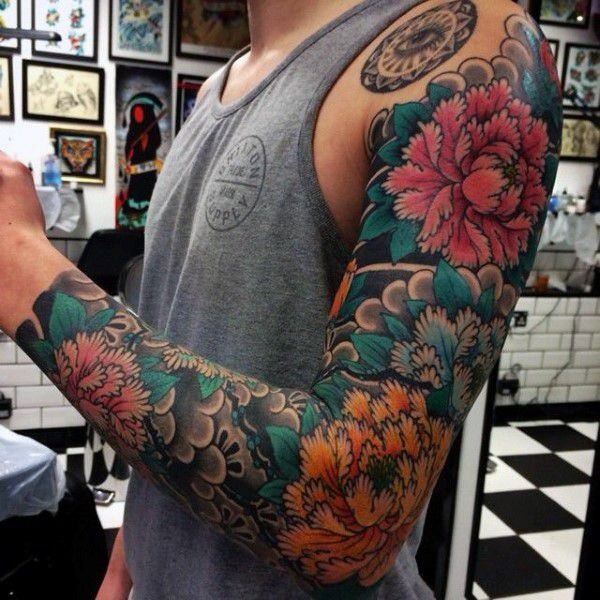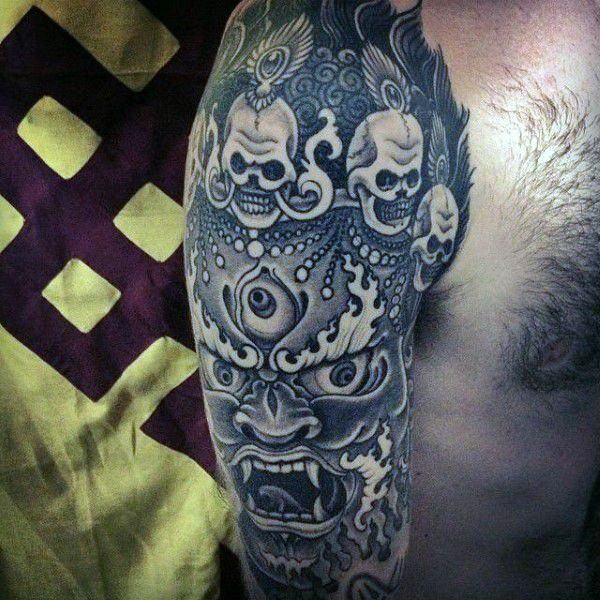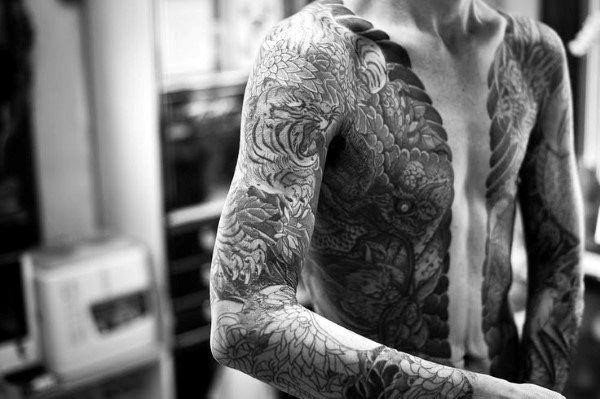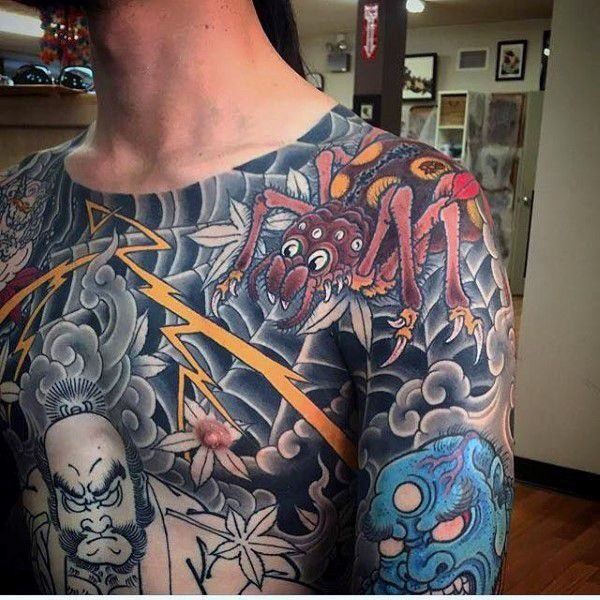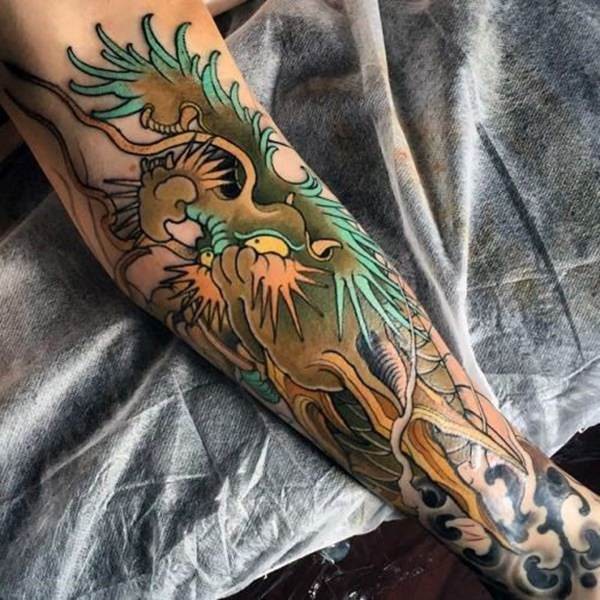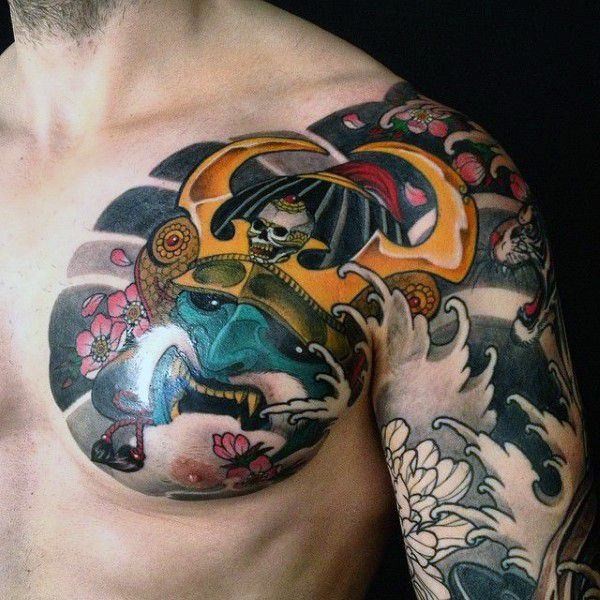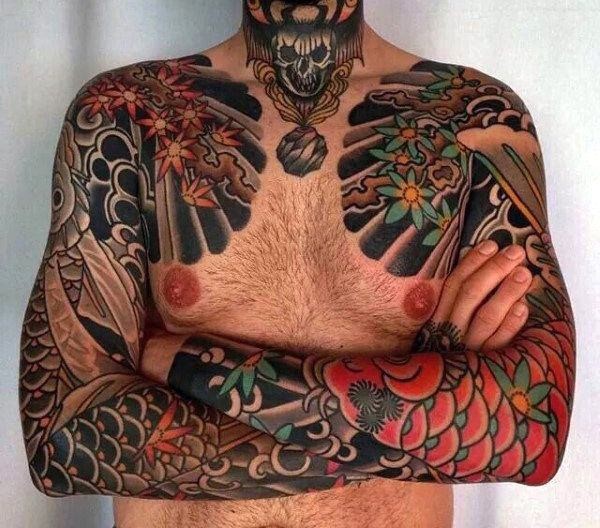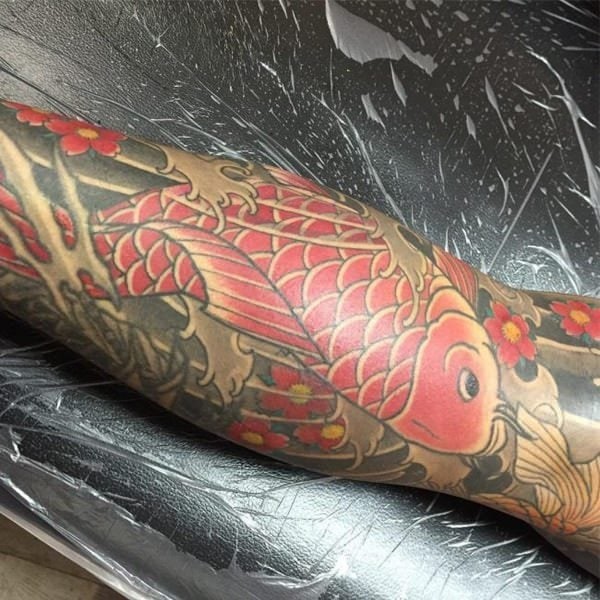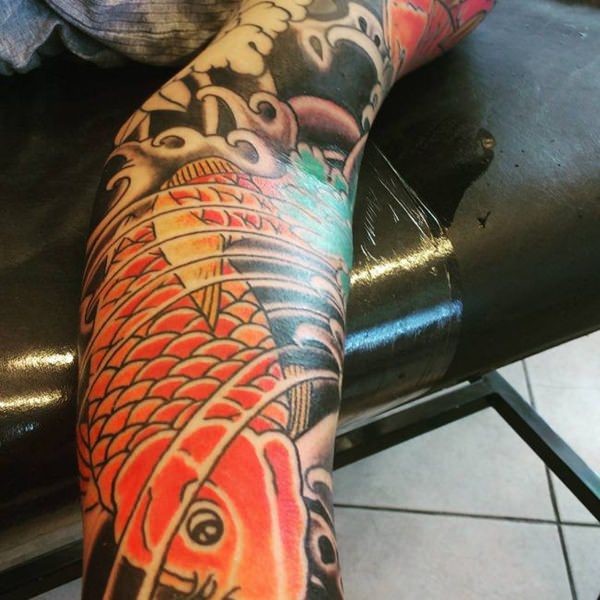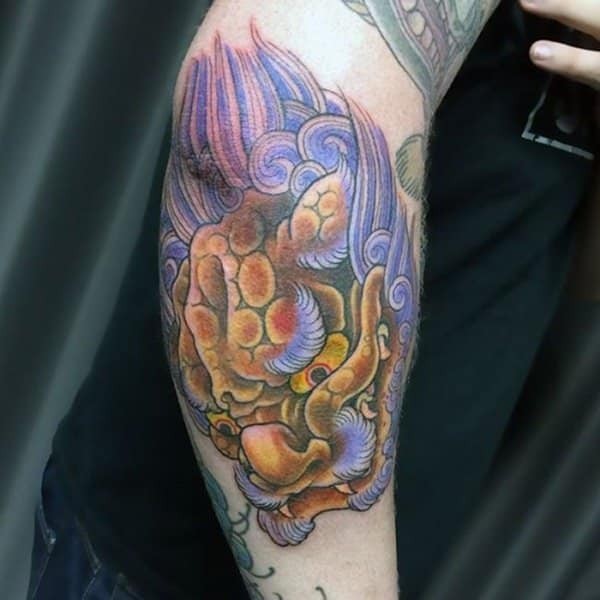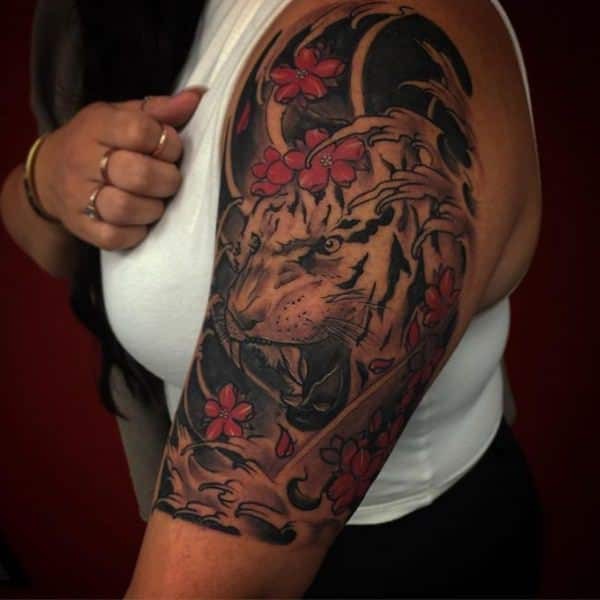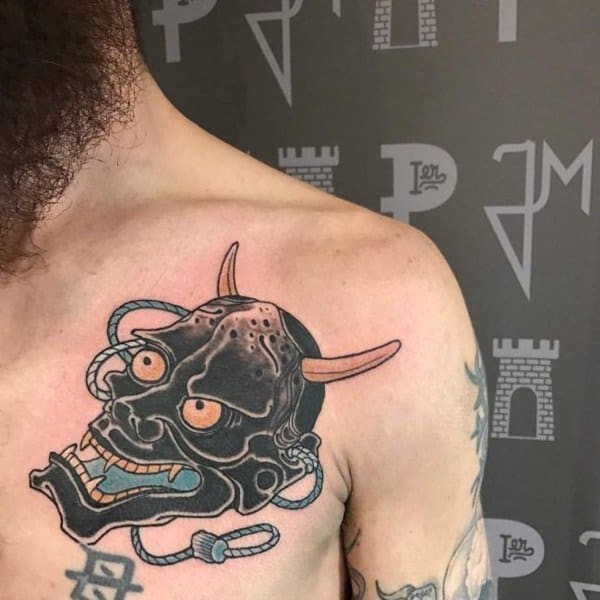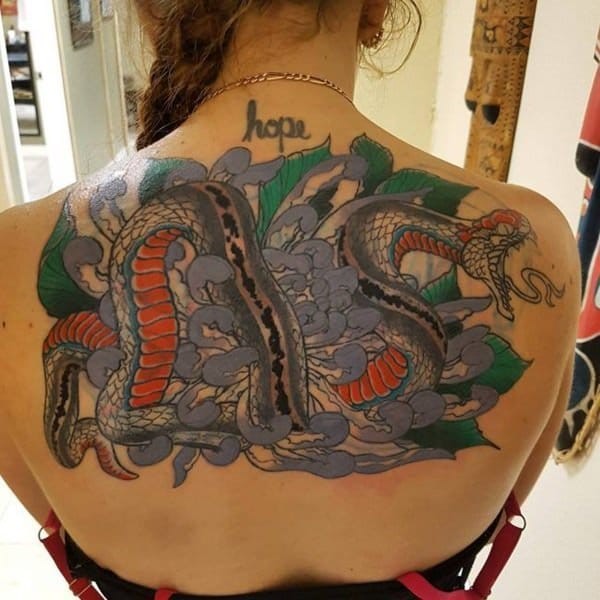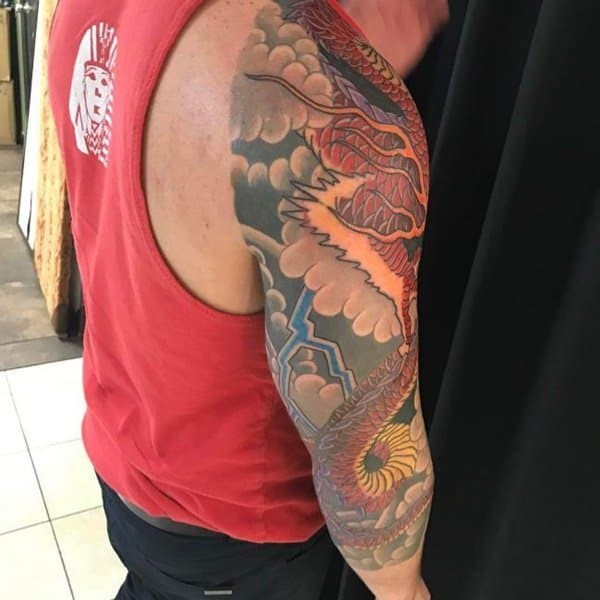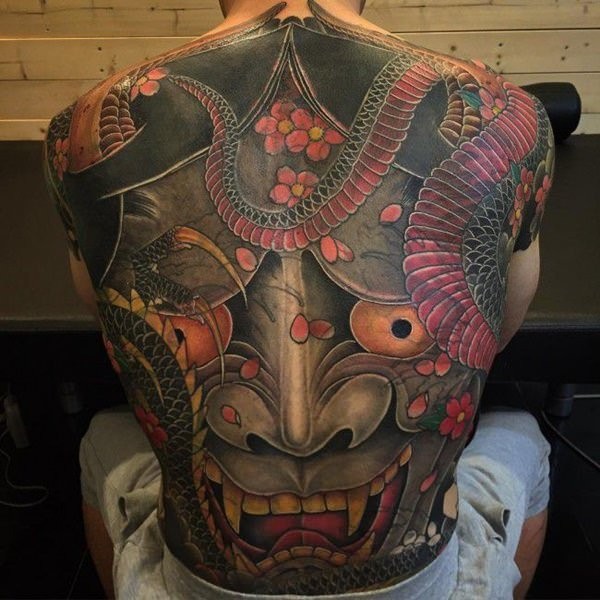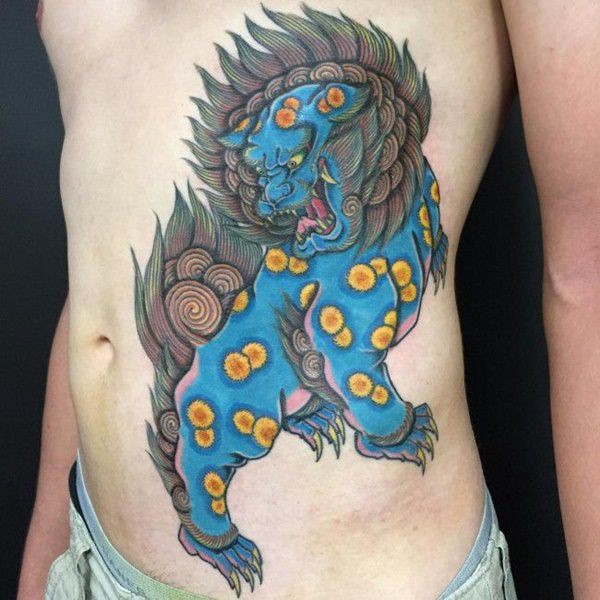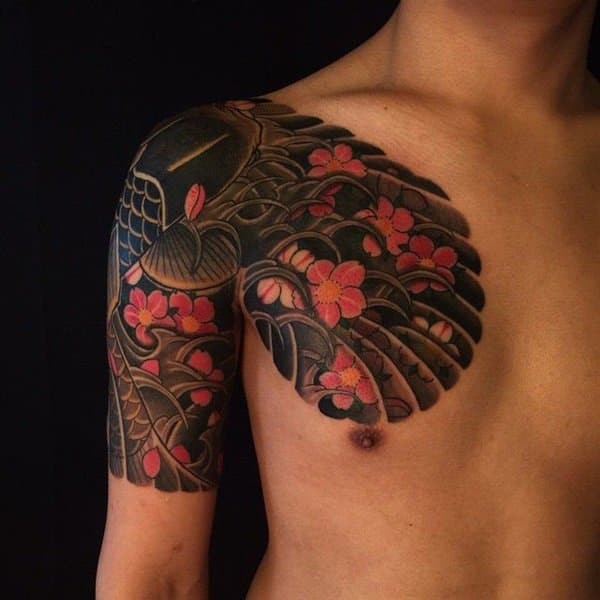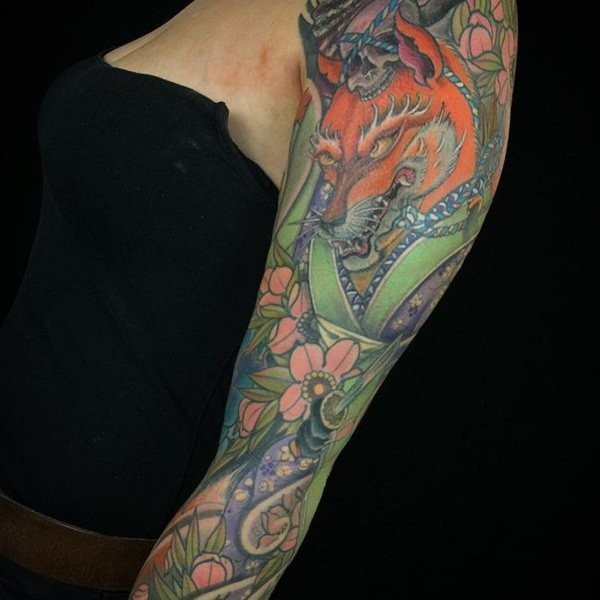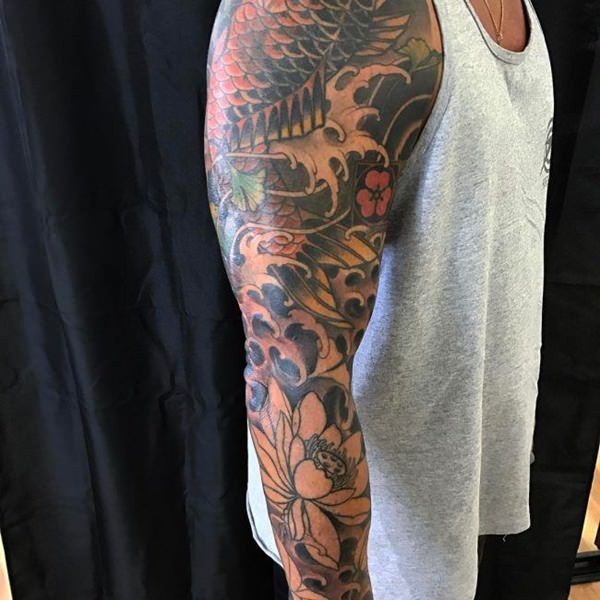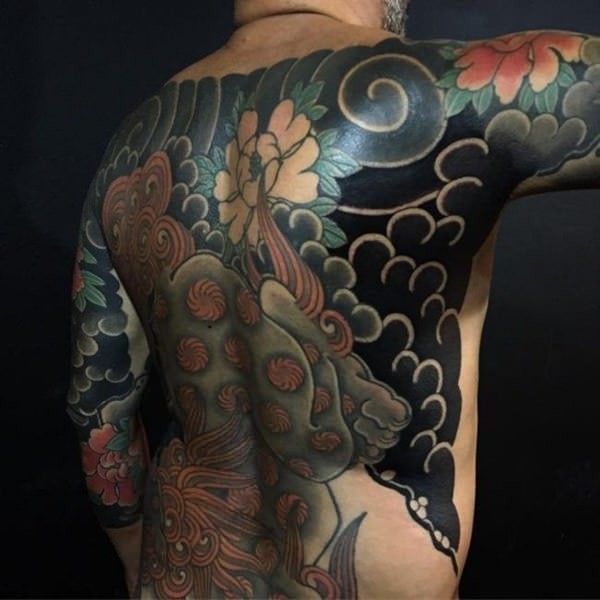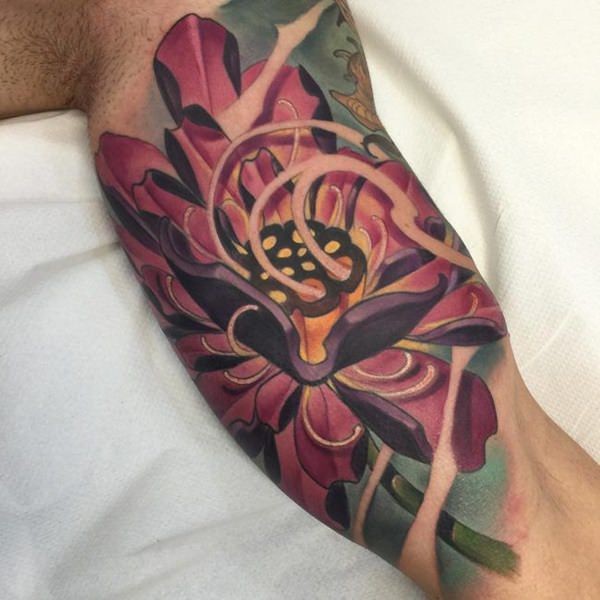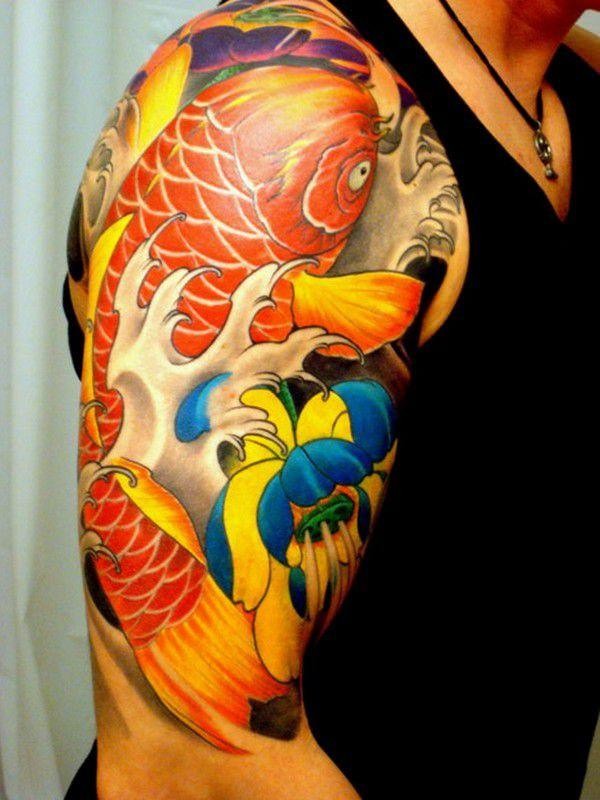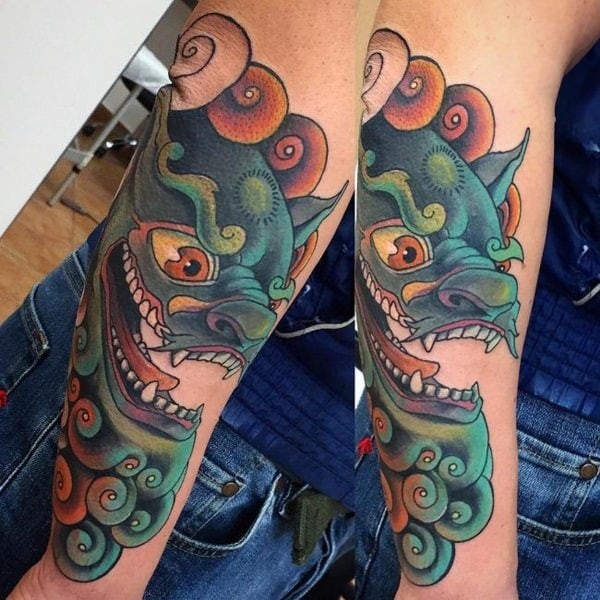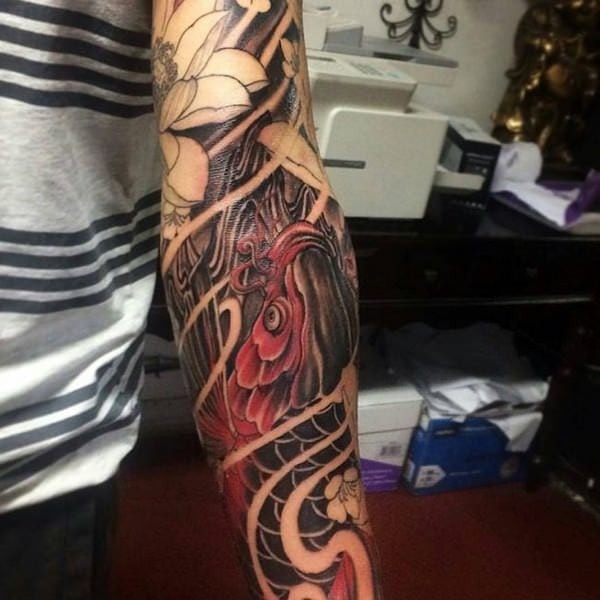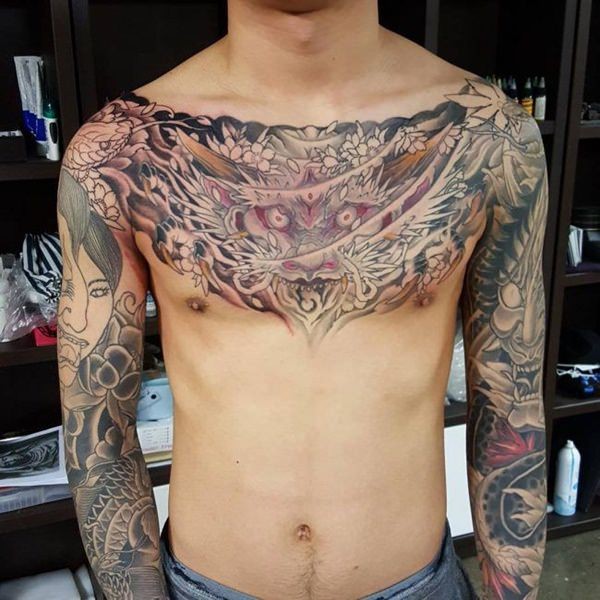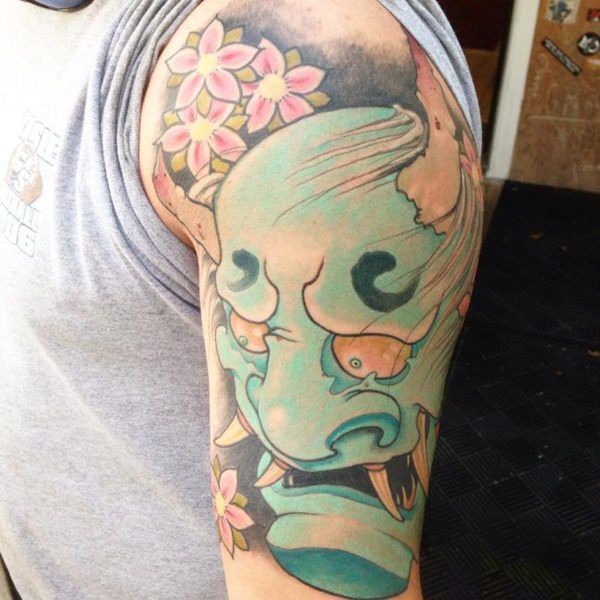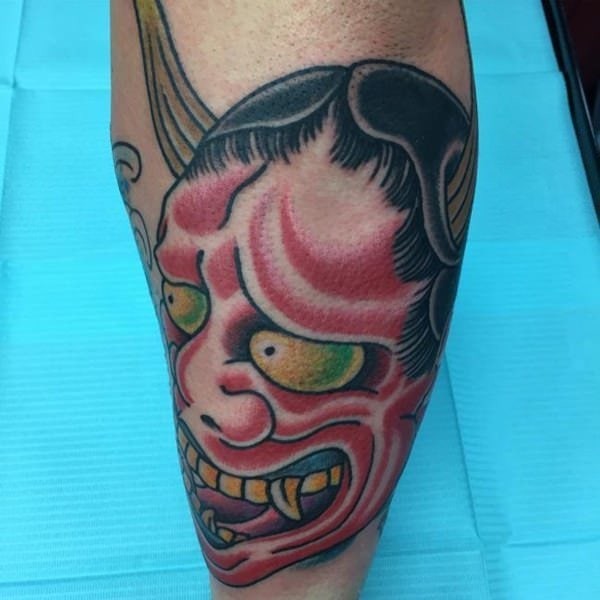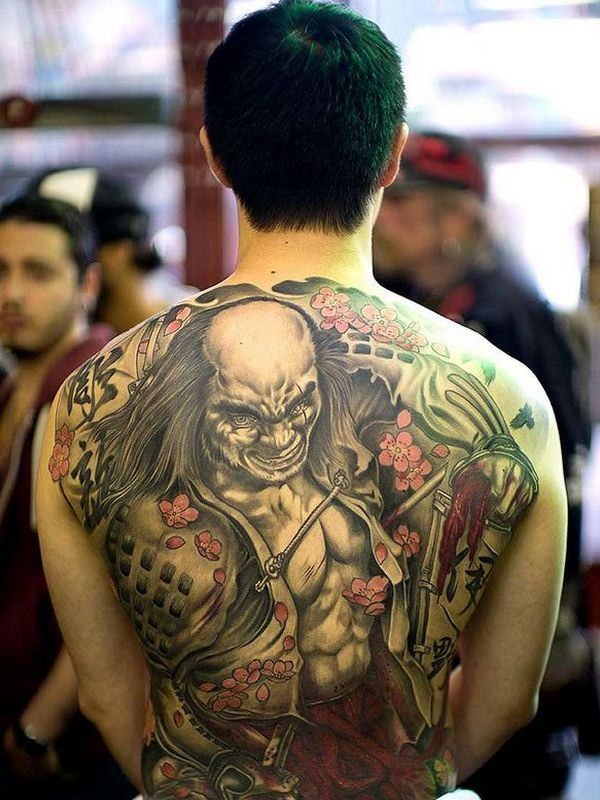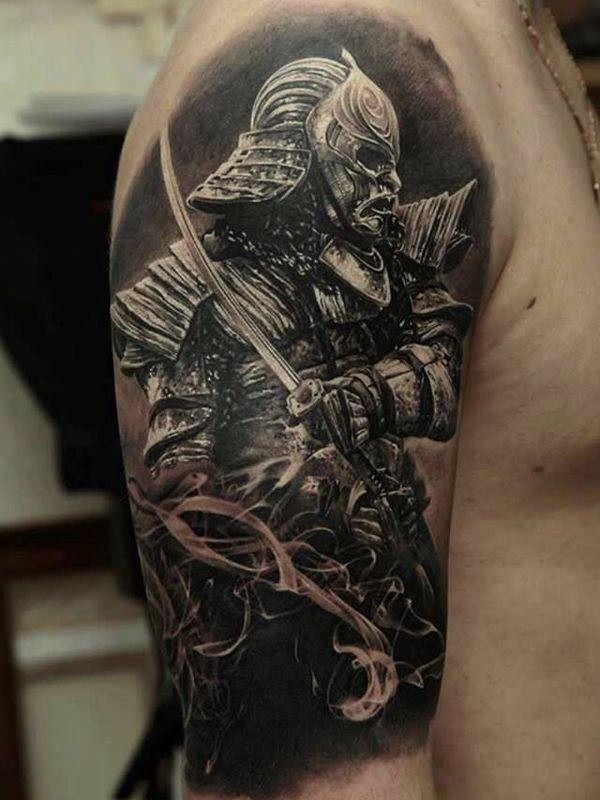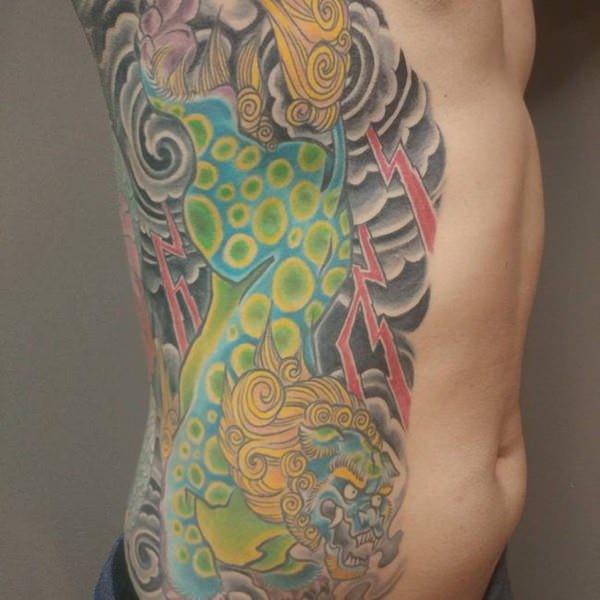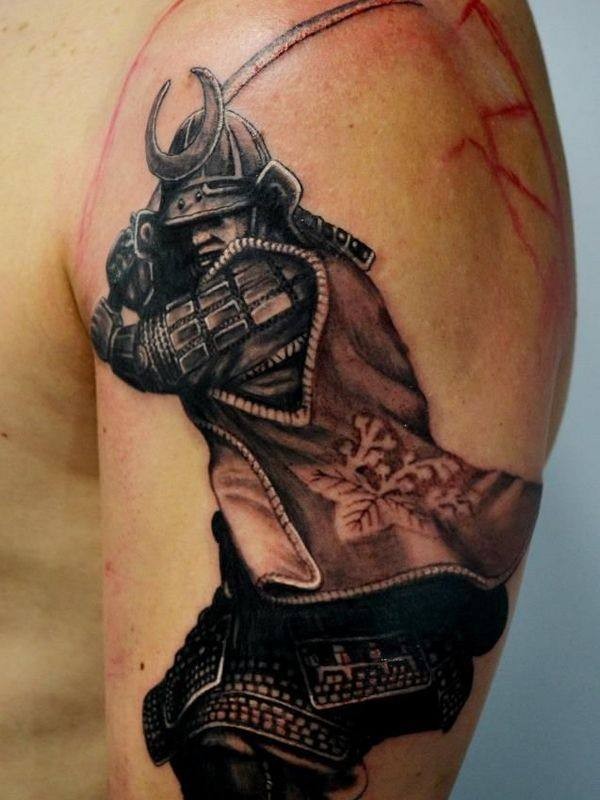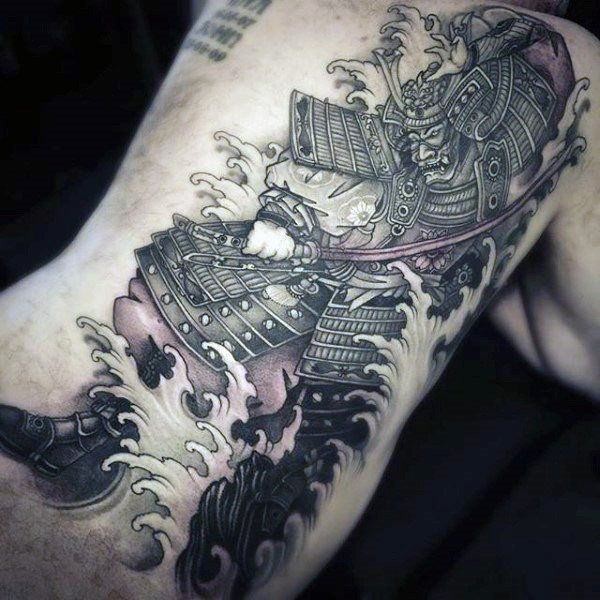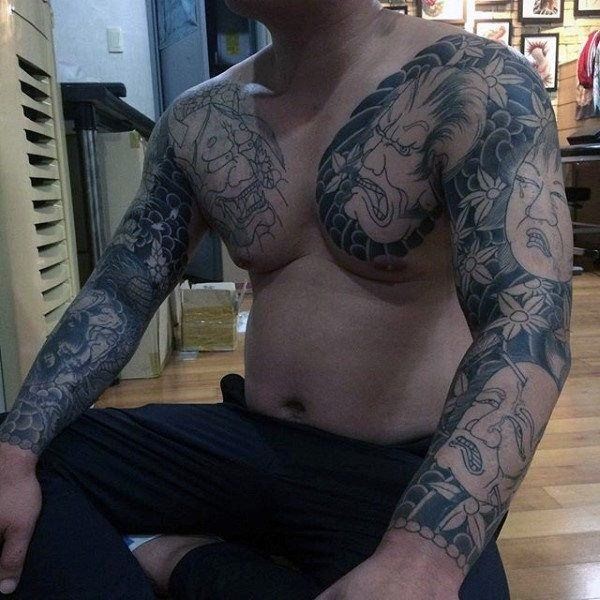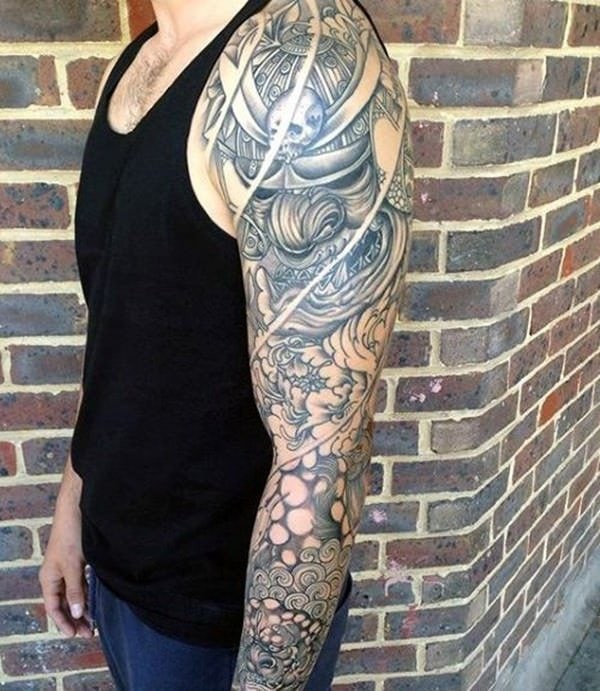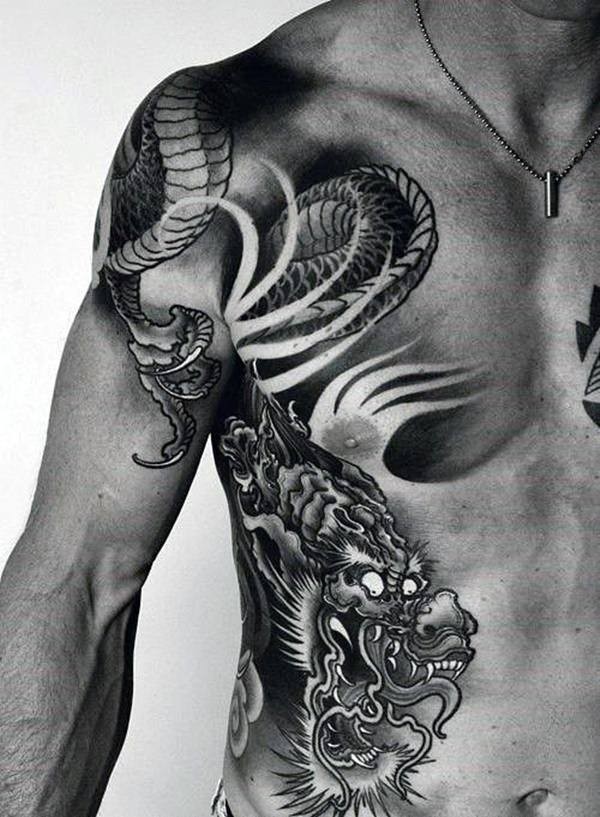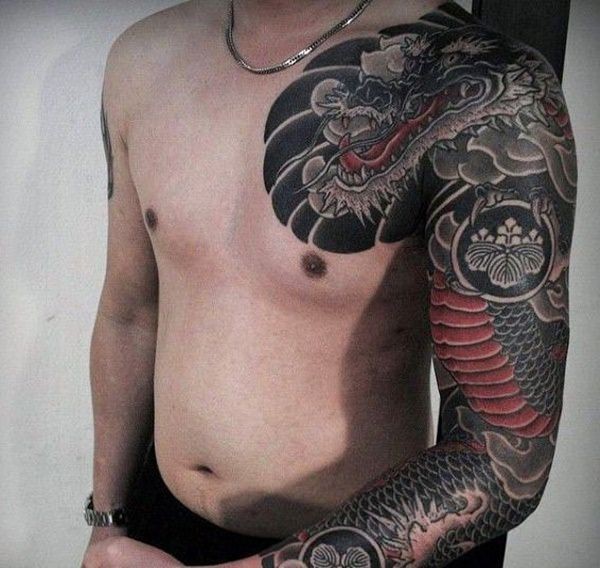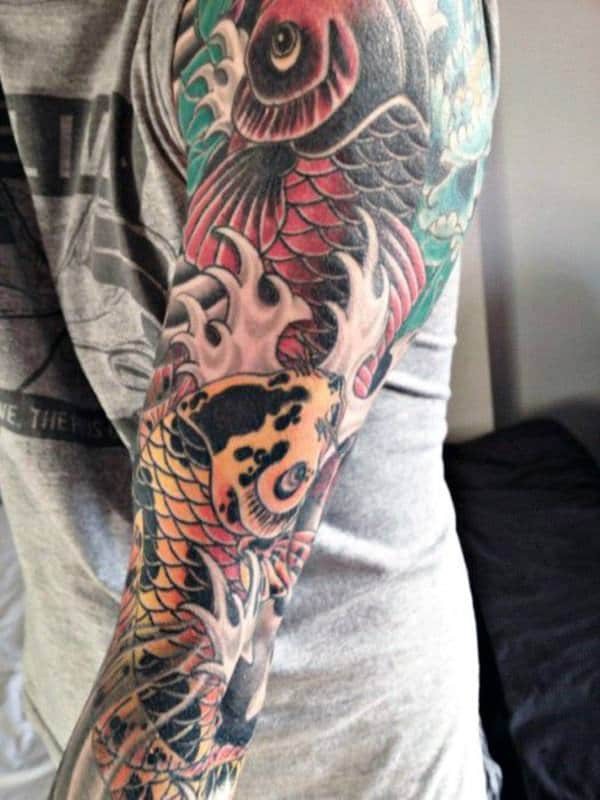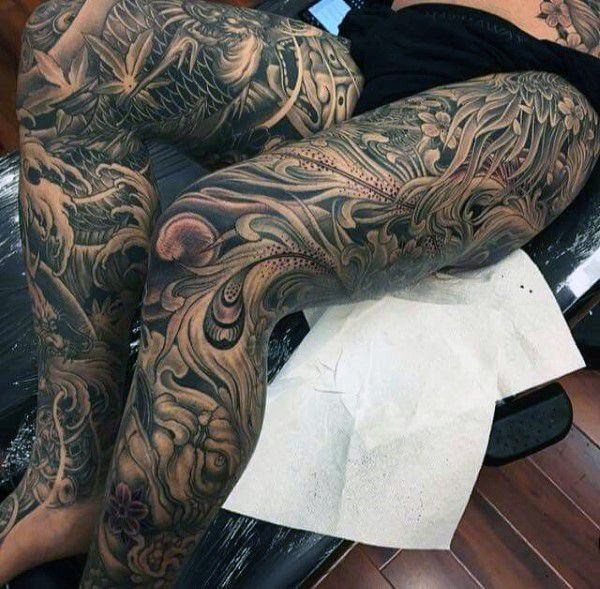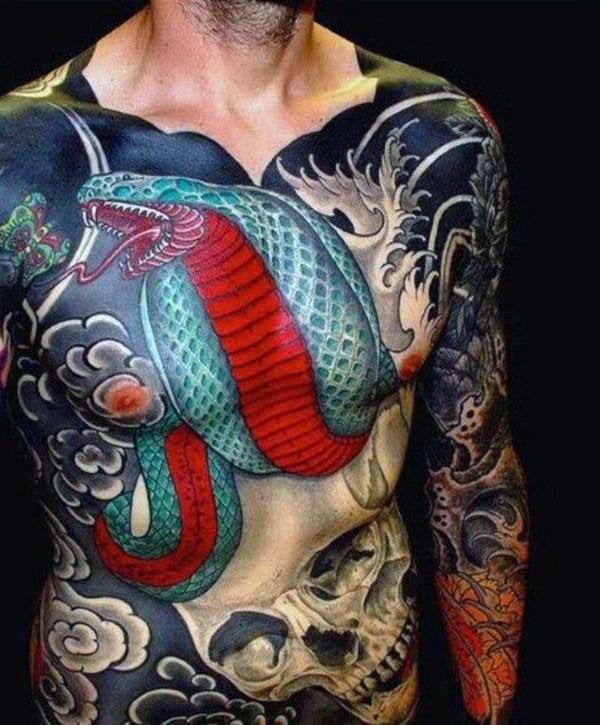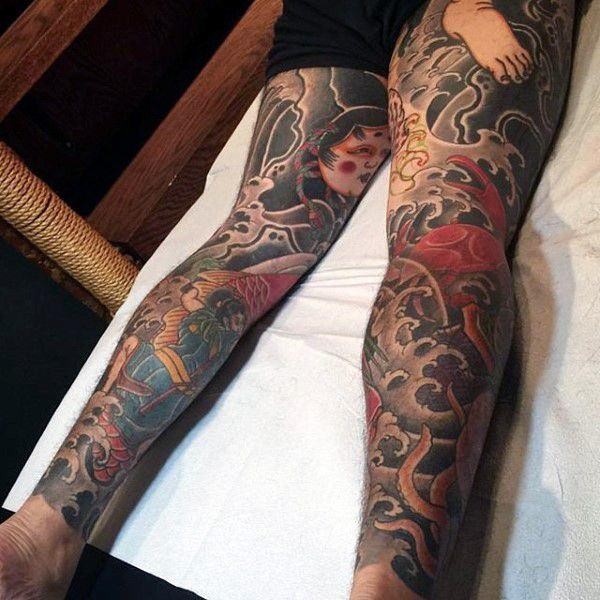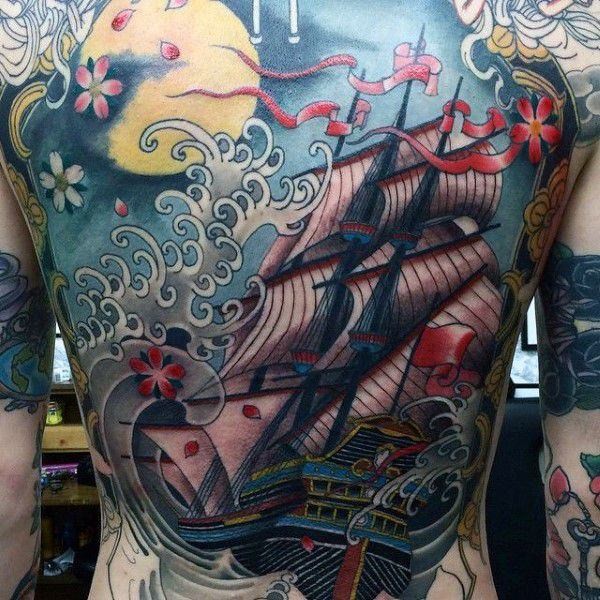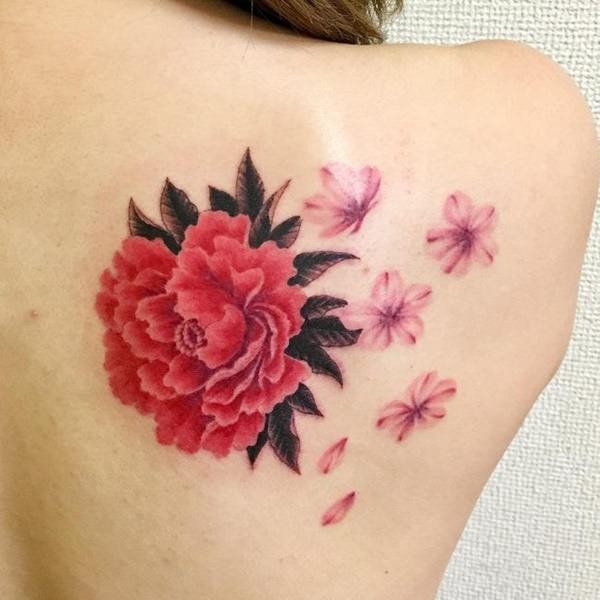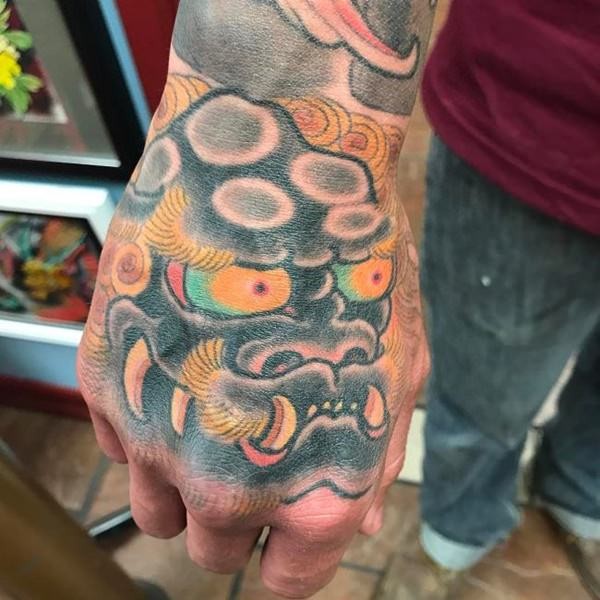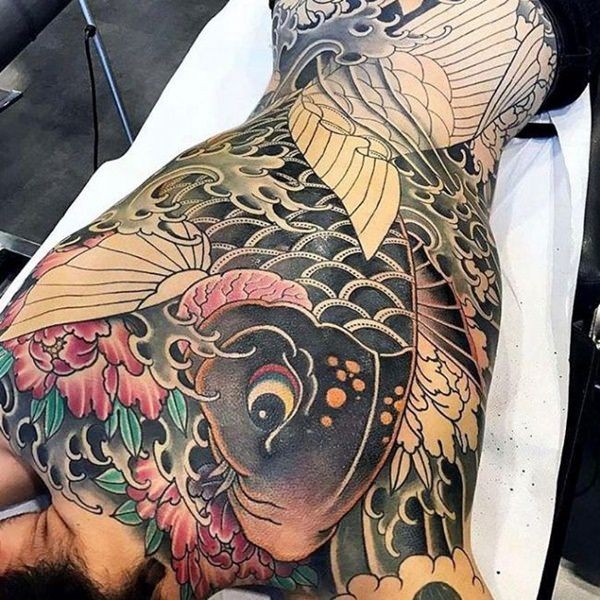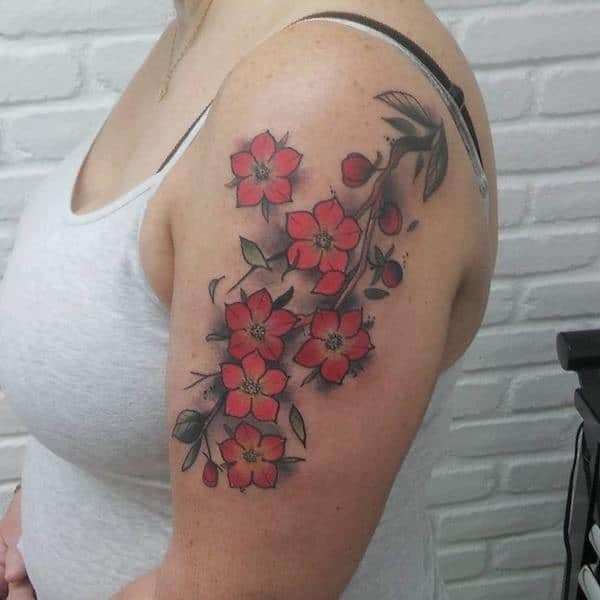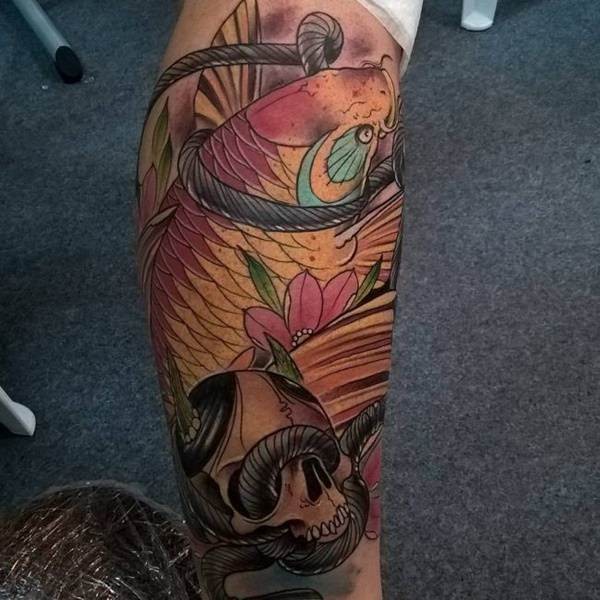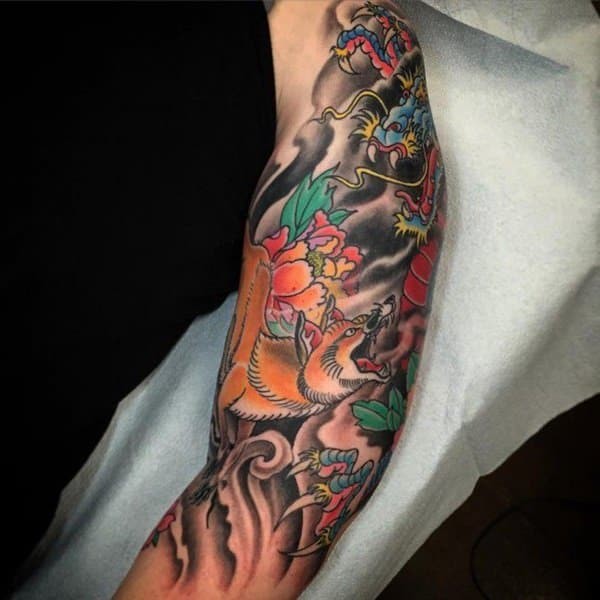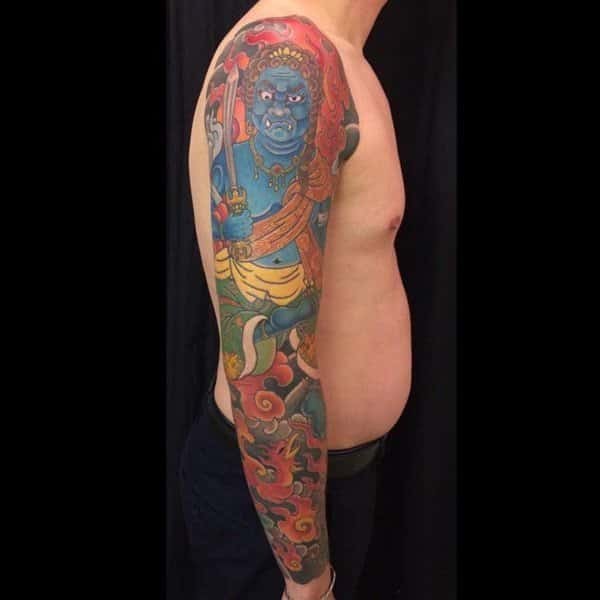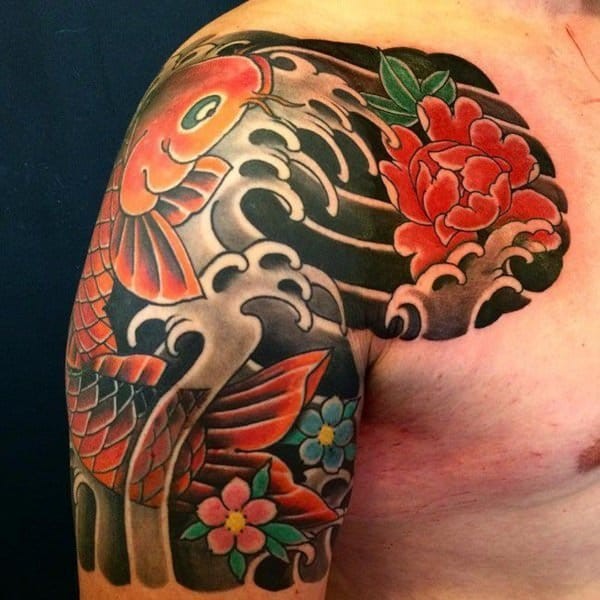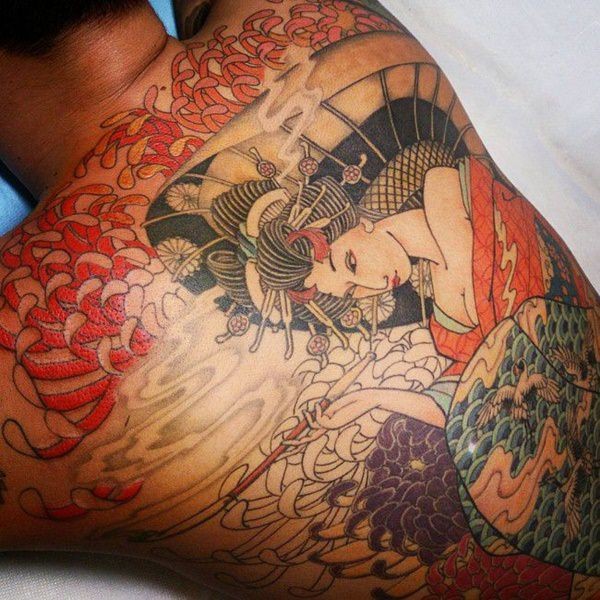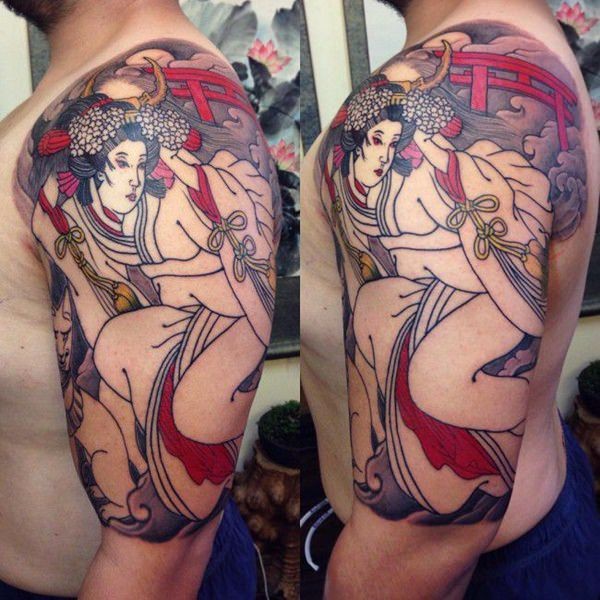Traditional Japanese Tattoos With Tiger
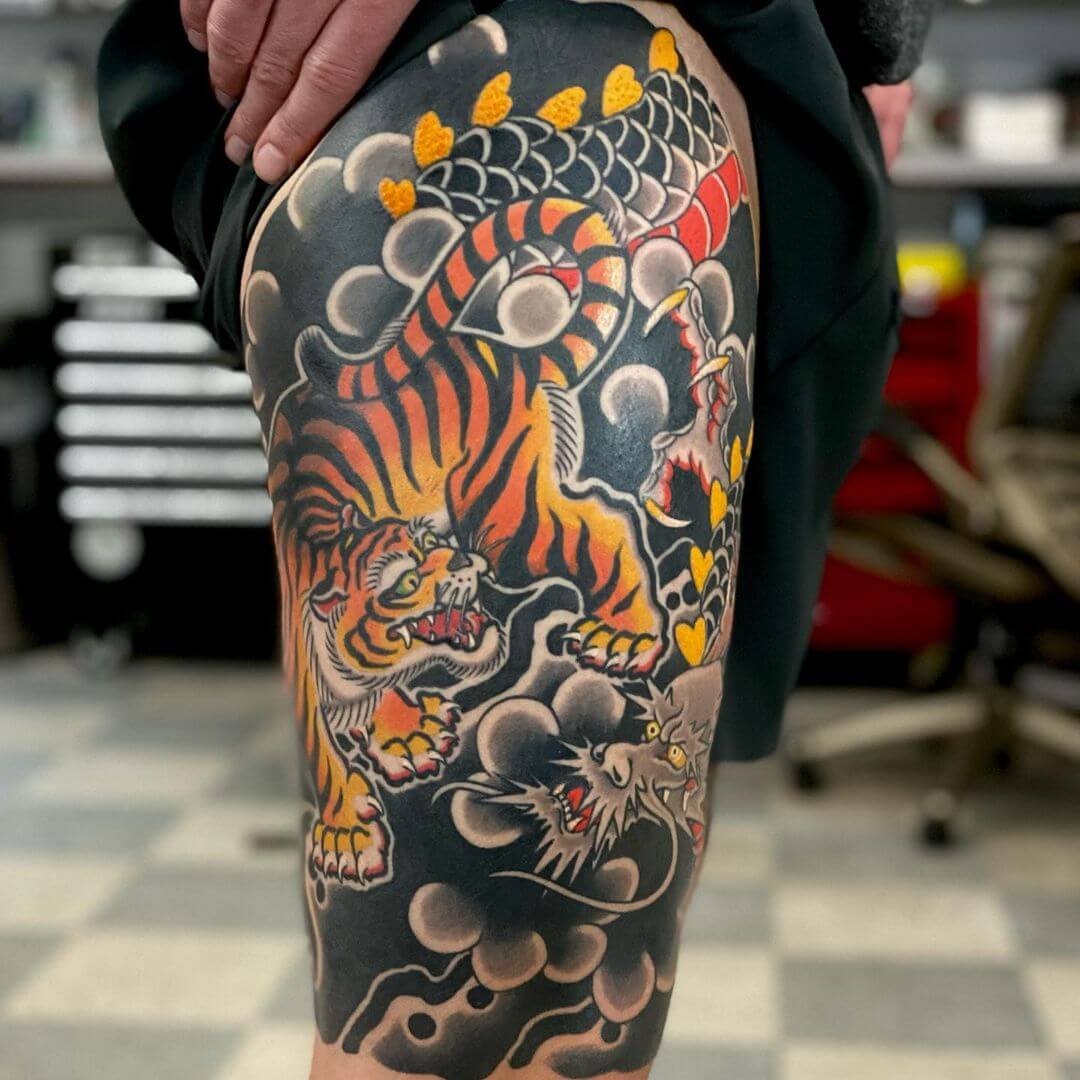
In the midst of a dark background, a vibrant tiger takes center stage, its features illuminated by a kaleidoscope of colors. A mysterious demon-like creature lurks in the bottom right corner, lending an air of intrigue to the overall design. This piece is a stunning representation of traditional Japanese art, deeply rooted in the country’s rich cultural heritage. As a symbol of good fortune and protection against malevolent forces, the tiger holds a revered place in Japanese tattooing tradition.
The level of detail in this intricate design necessitates a collaborative effort between artist and client to ensure its faithful execution. Those looking to customize their piece may experiment with varying hues for the tiger or add subtle nuances to the overall composition. This traditional Japanese tattoo sleeve is a prized possession among animal enthusiasts.
Irezumi Tattoo
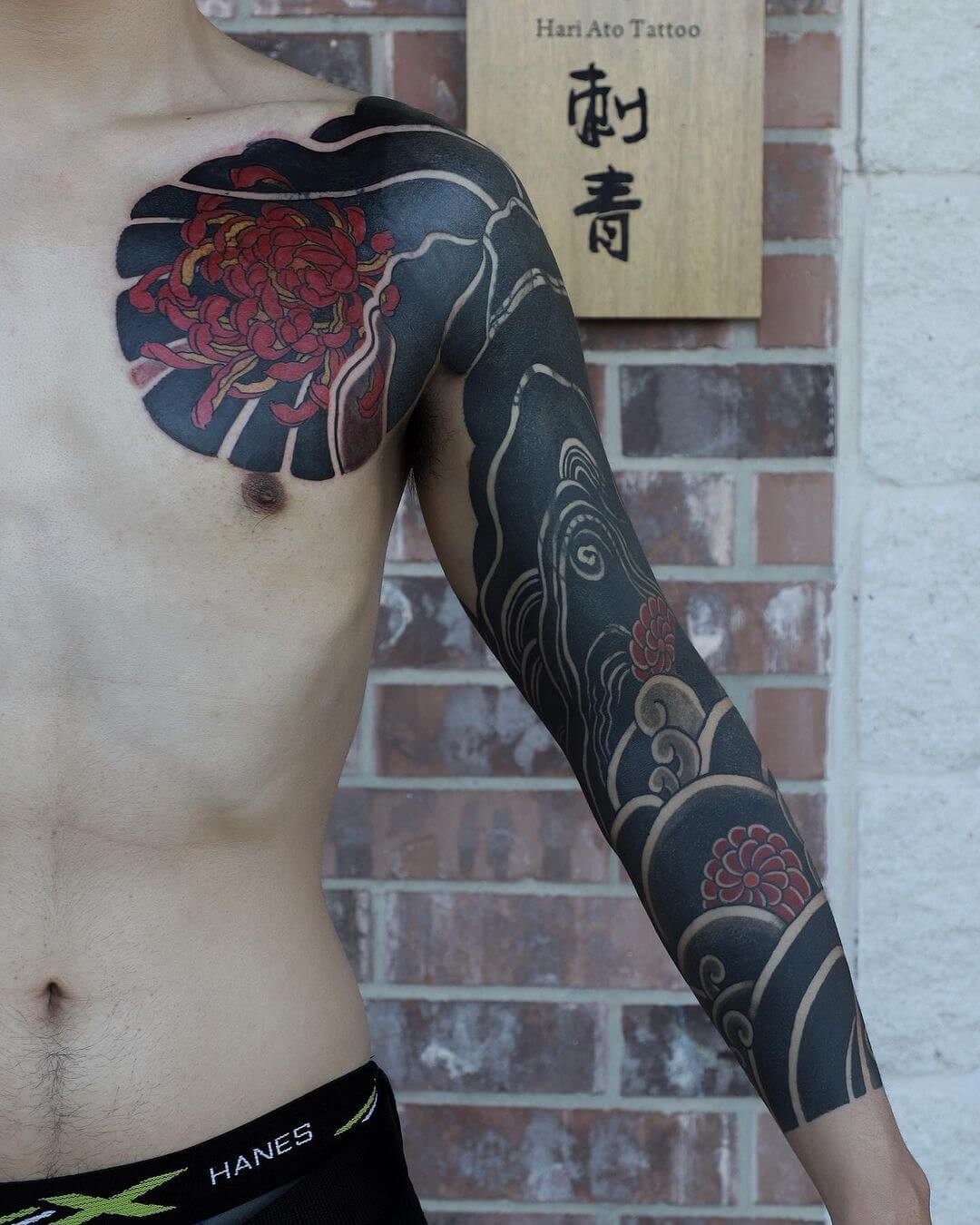
The vibrant colors used in this stunning Japanese tattoo are red, black, and a subtle hint of yellow. The design masterfully captures the essence of flowers blooming among waves, characteristic of traditional Hori-style tattoos. This iconic style is often employed by artists to signify their profession. In this case, the wave motif typically represents strength and fluidity, while the flowers embody perseverance.
The expert use of black and red hues creates a striking contrast, bringing the tattoo to life. The pop of color from the red flowers adds a unique dimension, allowing for potential variations by replacing the red with another hue. This breathtaking piece is undoubtedly one of the most impressive traditional Japanese tattoos we’ve had the pleasure of witnessing.
Colorful Japanese Tattoo
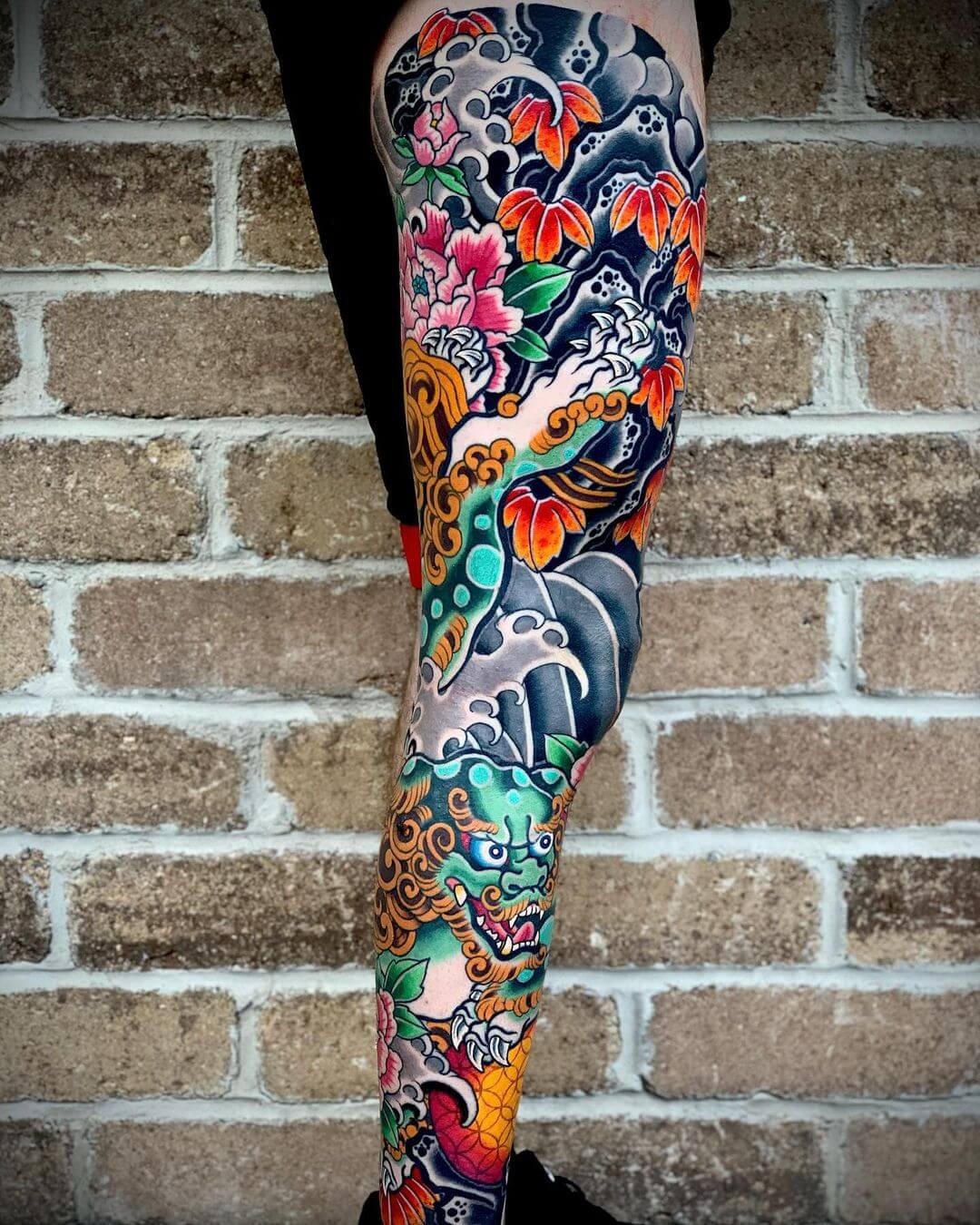
This intricate tattoo combines vibrant colors and iconic Japanese mythical creatures, weaving together a rich tapestry of symbolism. At its core, the design embodies protection, believed to ward off negative energy with its unique blend of elements. Delicate chrysanthemums and other flowers are scattered throughout, their petals donning hues of pink, white, or grey-blue.
The use of color holds significant meaning in Japanese tattoos, as red conveys joy, gold signifies power, blue represents fertility, while white symbolizes both mourning and new beginnings. Green, a ubiquitous shade, is deeply connected to nature. For those seeking a striking and meaningful Japanese tattoo, this design is sure to captivate.
Japanese Tattoos With The Crane
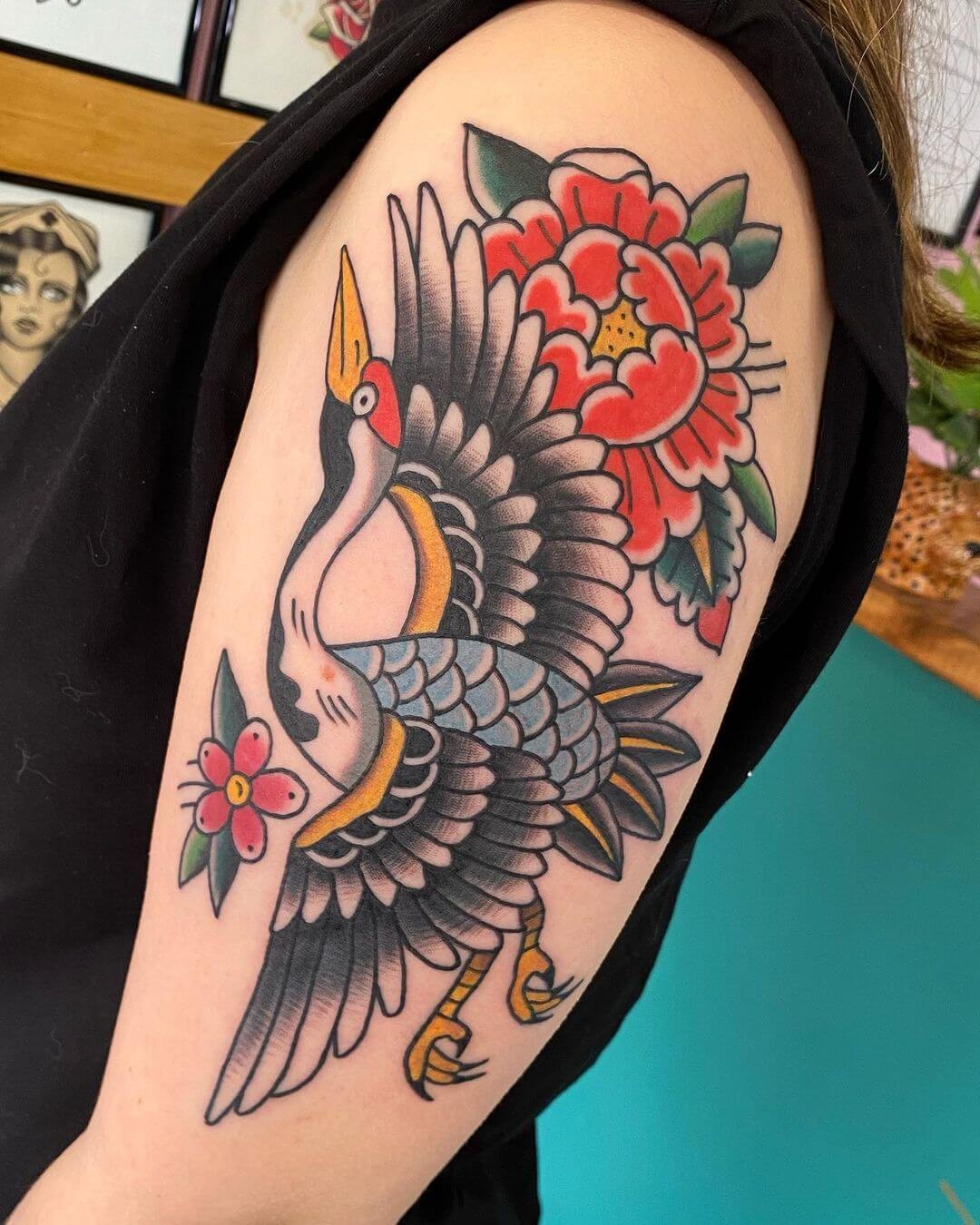
The symbolism surrounding cranes is deeply rooted in cultures that revere longevity, wellness, and serenity. In this striking tattoo design, the majority of the bird’s plumage and body are rendered in rich blacks with subtle hints of sunshine yellow. A soothing touch of light blue adorns the midsection, just below the neck, creating a sense of harmony. The beak and legs, meanwhile, exude warmth with their bright yellow hue.
Adjacent to the majestic crane stands a delicate cherry blossom, its petals shimmering in shades of pink and white. Hidden beneath the bird’s right wing lies a stunning rose, its velvety red petals unfolding like a secret garden. The tender leaves peeking out from below add a touch of whimsy, as do the blossoms, blending seamlessly with the crane’s ethereal beauty.
The artist’s mastery of capturing the bird’s fluid motion is nothing short of breathtaking, with each feather meticulously rendered to create an aura of serenity.
Traditional Japanese Tattoo With Cat
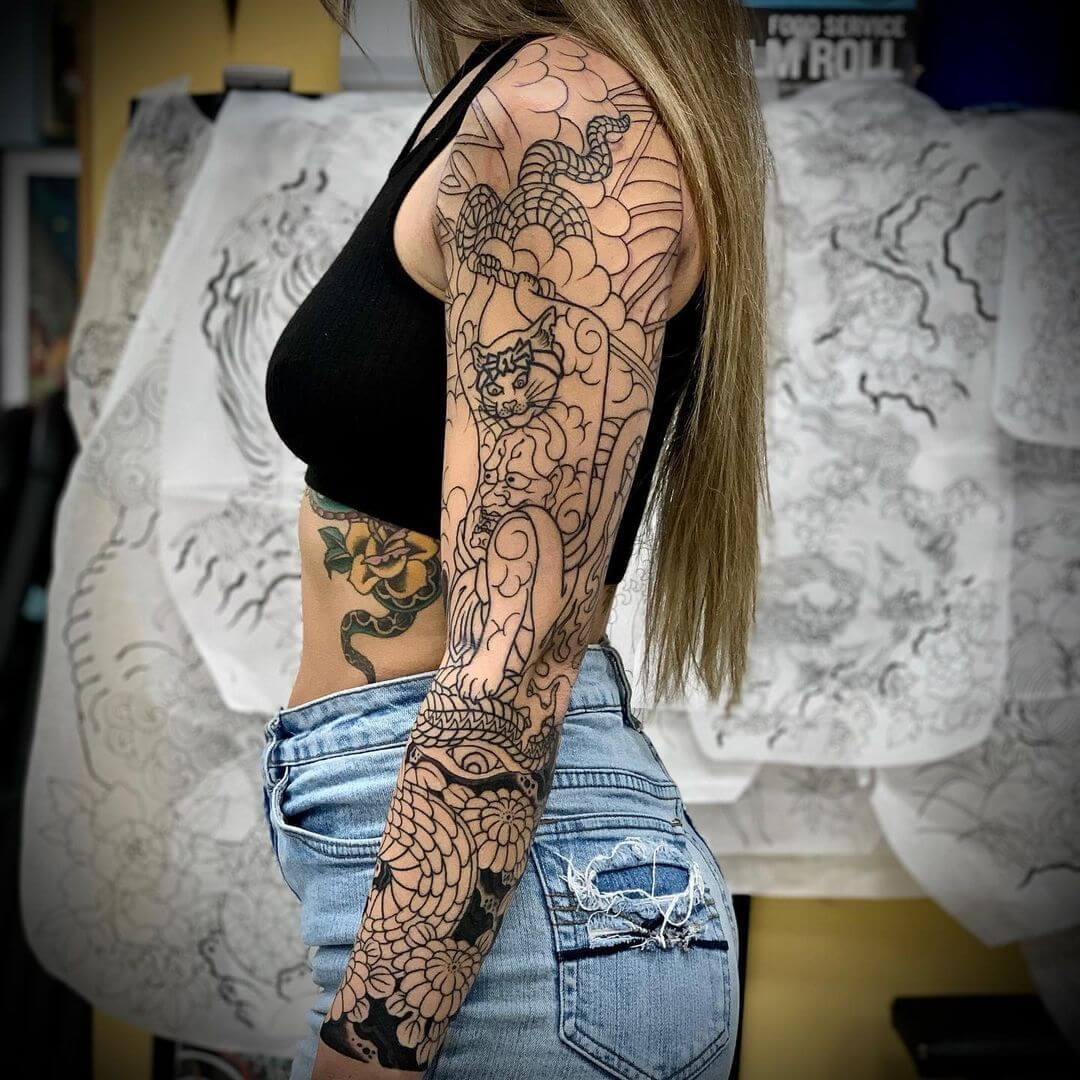
This Japanese traditional sleeve tattoo stands out for its ability to accommodate large designs without feeling overwhelming. The focal point is a majestic cat suspended from a delicate branch, adorned with a charming head wrap and rendered using curved lines that give the impression of soft fur. A lush bed of flowers and leaves stretches out beneath its paws, while an intricate design on its stomach pays homage to Shinto deities, showcasing exceptional craftsmanship.
As a nod to Japanese folklore, this enigmatic feline embodies the virtues of good health, fortune, and strength – transforming from mere creature to potent symbol. For cat enthusiasts, this tattoo is a must-have!
Hyottoko Traditional Japanese Tattoo
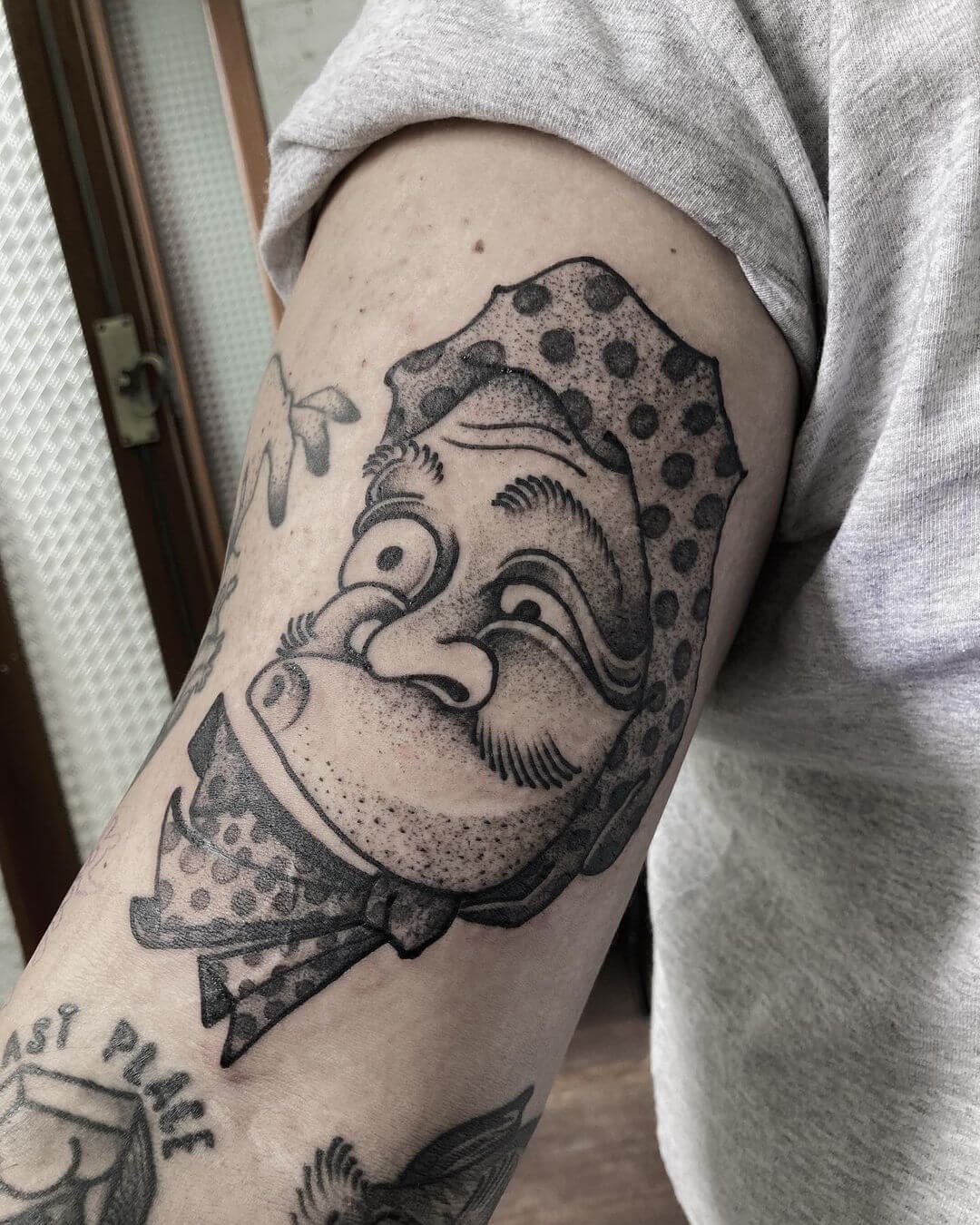
Hyokotto, a beloved comedic character in Japanese folklore, takes center stage in this design. Wearing a mask adorned with exaggerated features – oversized eyes and a pointed chin – along with a printed scarf, he exudes a playful demeanor. The addition of wrinkles on his forehead subtly conveys his age, while the detailed depiction of his bushy brows and mustache adds to the comedic charm. Interestingly, the pointed shape of his chin is a result of his habit of smoking a bamboo pipe.
For those who prefer a more feminine take, the character’s female counterpart, ‘Okam,’ offers an intriguing alternative. While this design is monochromatic in its current form, it’s easy to envision adding vibrant colors to bring Hyokotto’s whimsical nature to life. As such, this unique traditional Japanese tattoo serves as an excellent choice for those seeking a truly one-of-a-kind design.
Floral Japanese Tattoos
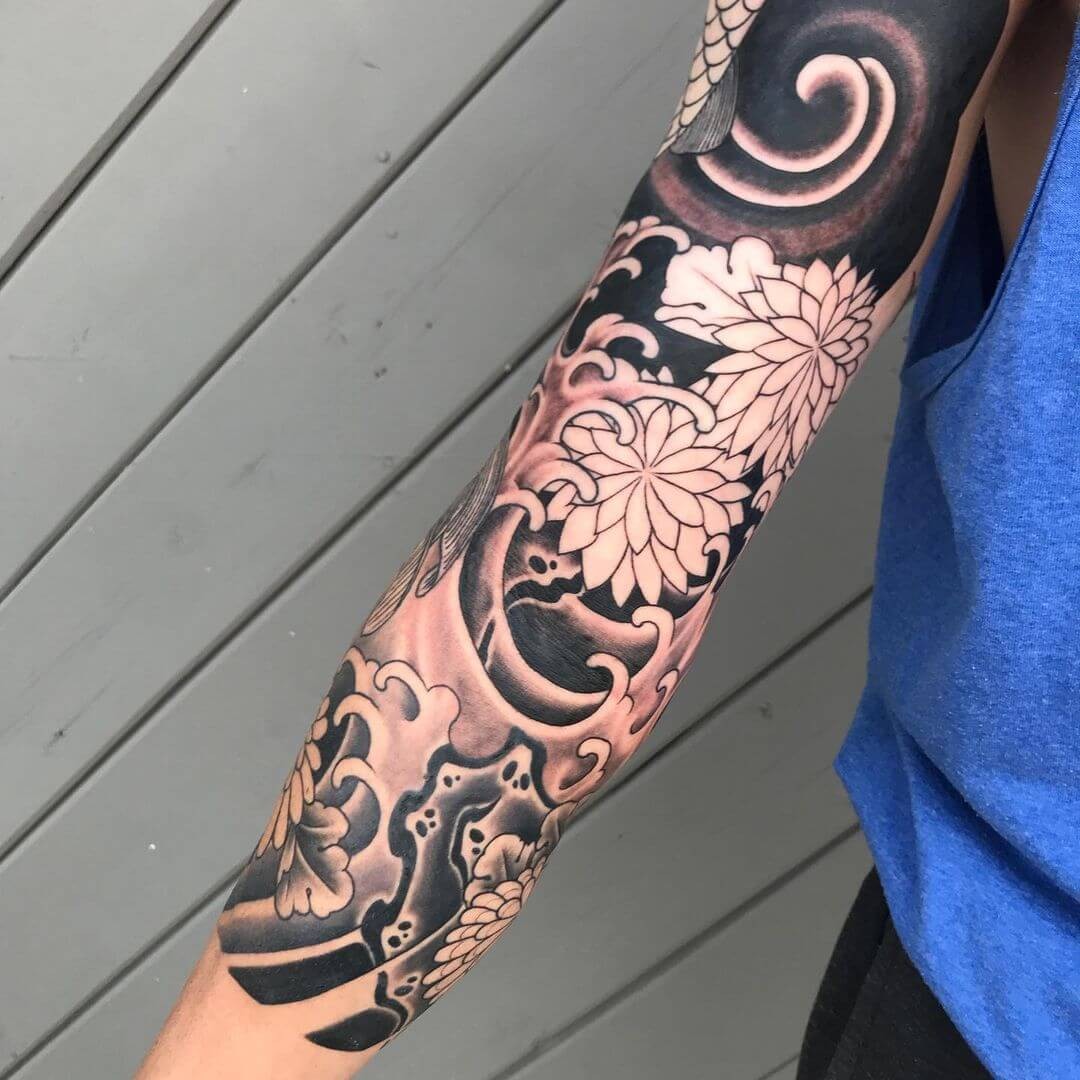
The timeless allure of floral tattoos lies in their unique meanings and visual appeal. The Japanese have a deep affinity for these designs, which are believed to bring prosperity and good health. This particular design stands out with its striking black base, punctuated by subtle pink accents at strategic corners. Delicate waves above and below the flowers add texture and dimensionality, making this piece truly special.
For those looking for inspiration, the lotus flower or cherry blossoms can be incorporated to create a softer, more ethereal appearance. If you prefer a brighter, more vibrant design, feel free to introduce lighter hues that suit your personal style. As it is, this version exudes a charming simplicity. When seeking a Japan-themed tattoo, consider collaborating with Japanese artists who are steeped in the culture and tradition of these beautiful designs – the result will be truly unforgettable.
Japanese Chrysanthemum Tattoo
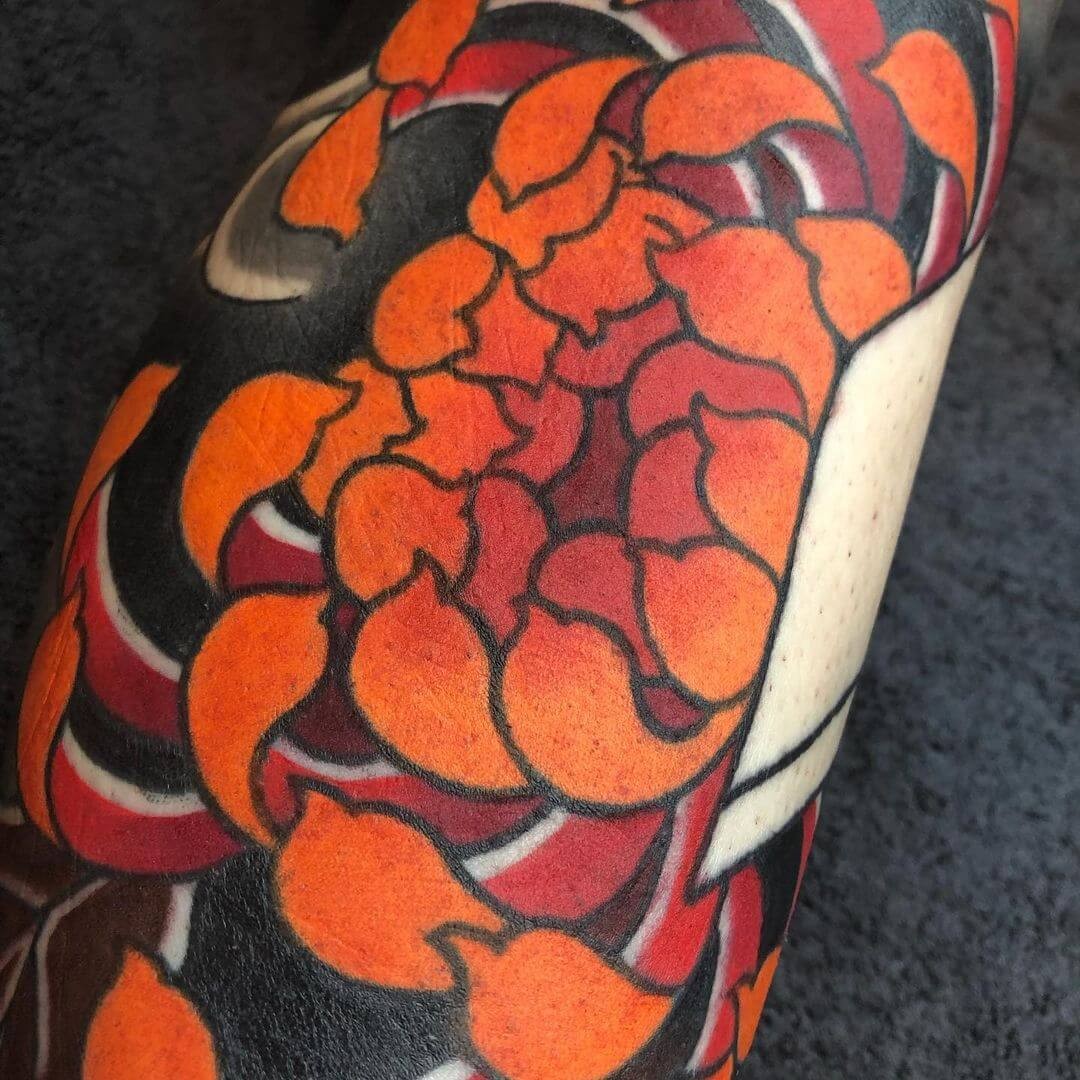
In Japan, the Chrysanthemum is an iconic symbol of power and determination, making it a unique choice for a bold and vibrant arm or leg tattoo. The design features a large, intricately detailed Chrysanthemum in shades of red and orange, with subtle accents of black and white that add depth and visual interest. Every petal is precisely outlined in black, creating a striking graphic effect that adds to the overall impact of the design.
The use of two distinct red hues gives the tattoo an extra layer of realism and allure. This Japanese-inspired tattoo design is perfect for those who want a statement piece that’s both eye-catching and meaningful. Its relative rarity as a tattoo subject also makes it a great choice for anyone looking to add some subtle uniqueness to their design, without venturing into more exotic or untested styles.
Traditional Samurai Tattoo
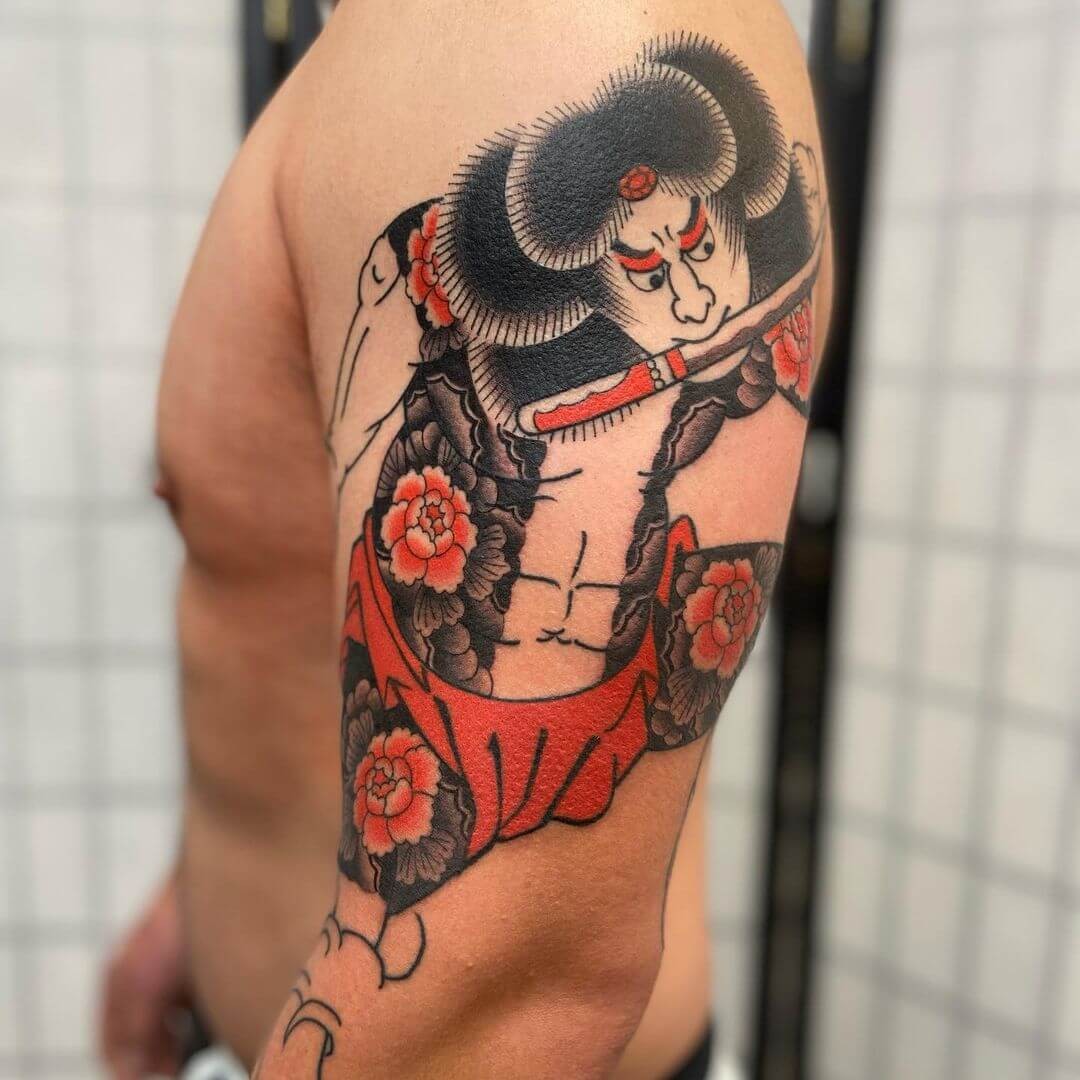
In ancient Japan, samurais embodied strength and valor, their reputation as warriors preceding them. This design pays homage to that legacy, featuring a samurai with his sword at the ready – even in this depiction, he’s shown with his sword held firmly in his mouth. The vibrant color palette is dominated by red, which adorns the samurai’s face, headwear, and sword. Five crimson flowers bloom amidst the design, their black-inked leaves adding depth and contrast.
The intricate details of the headwear are truly noteworthy, showcasing the artist’s exceptional skill. This tattoo art is a masterclass in traditional Japanese design, making it an ideal choice for those looking to adorn their sleeve with a powerful and meaningful piece.
Koi Fish Tattoo Design
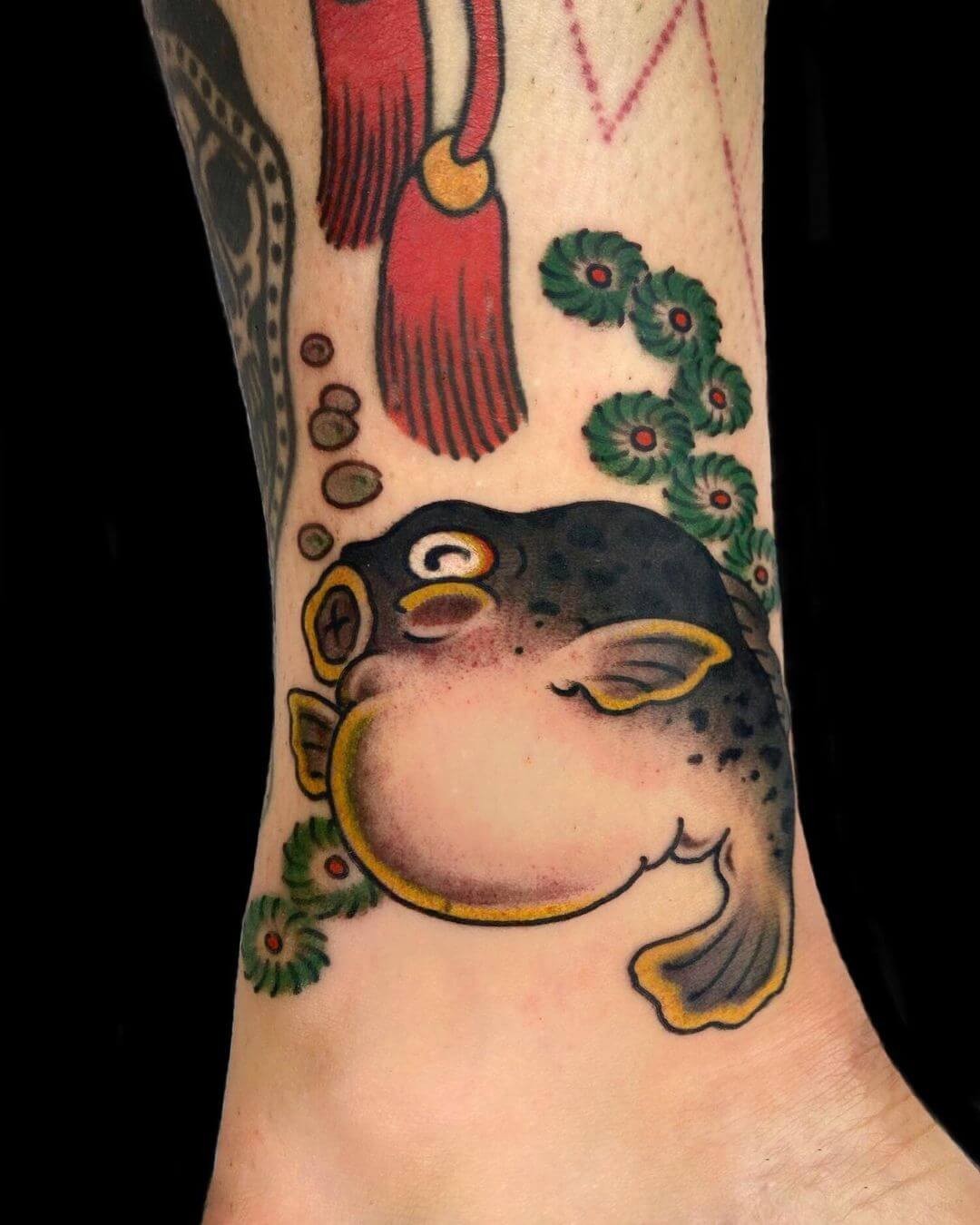
Koi fish tattoos are a powerful symbol of perseverance, resilience, and prosperity. The subtle blend of black, grey, and pink hues creates a striking visual effect, while the small black spots add depth and dimension to the design. The vibrant yellow outlining on the fins, tail, and mouth lining provides a pop of color, drawing the viewer’s eye to the koi’s features. The delicate bubbles rising from its mouth add a touch of whimsy and playfulness.
Amidst the ocean-inspired scene, dark green leaves surround the fish, creating a sense of harmony and balance. The puffy belly effect is achieved through masterful shading, giving the design a tactile quality. This neo-traditional tattoo, inspired by Japanese aesthetics, showcases the artist’s skill in blending modern techniques with traditional elements.
The same design can be effectively replicated on the arm or other areas of the body, making it an attractive option for those seeking a unique and meaningful piece of body art.
Japanese Tattoo Traditional
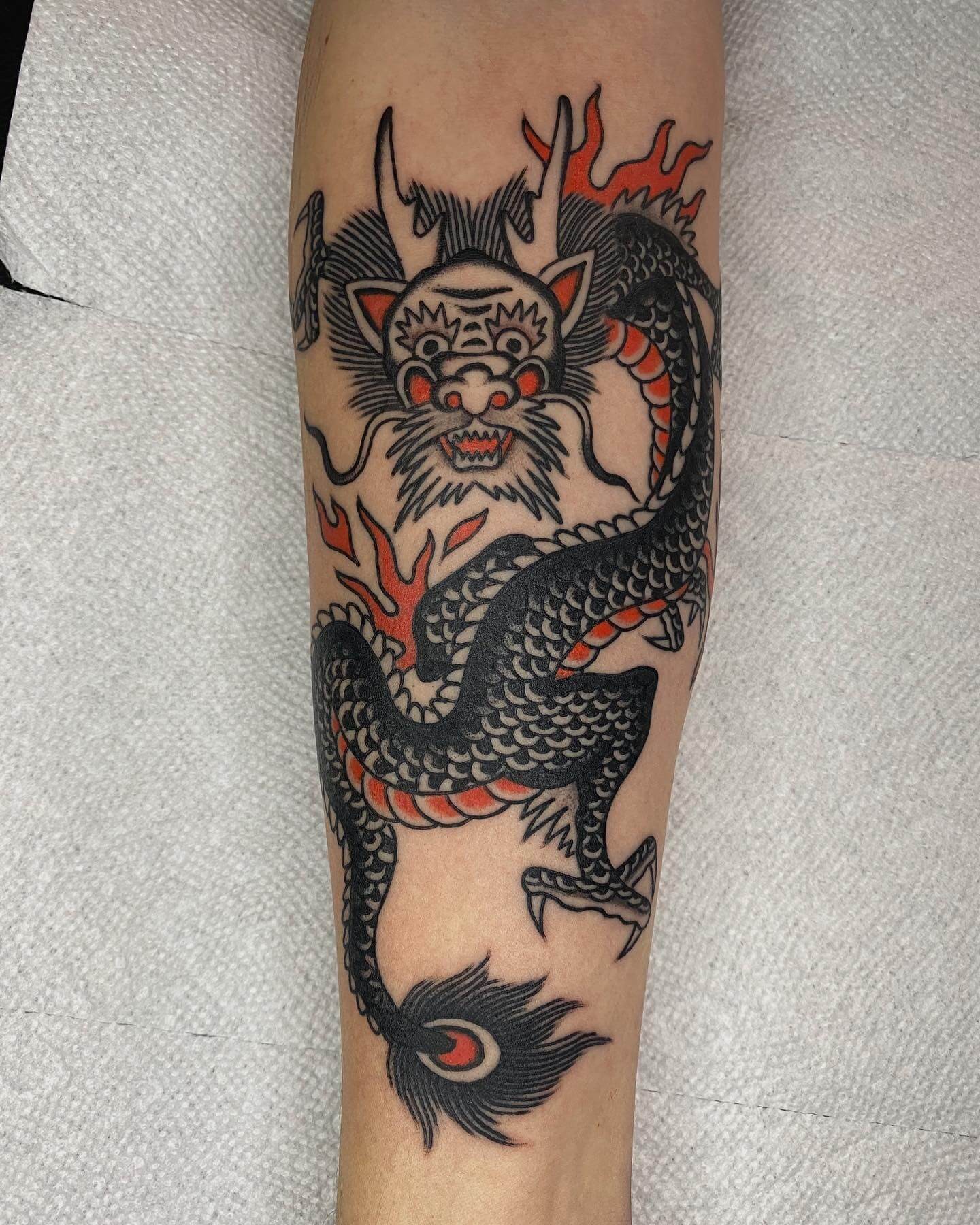
In recent years, Tokyo has become a mecca for tattoo enthusiasts seeking to experience the rich cultural heritage of traditional Japanese tattooing. Many have made the pilgrimage to immerse themselves in the art form, and even some tattoo artists have traveled to learn from the masters. With such a wealth of inspiration to draw upon, it’s no wonder that many have been drawn to the unique aesthetics and symbolism of traditional Japanese tattoos.
Whether you’re interested in incorporating elements like Japanese dragons or phoenixes into your own design, or seeking out inspiration for smaller, more subtle tattoos, there are countless options to explore. And for those looking to take their tattoo artistry to the next level, a traditional Japanese tattoo sleeve or back piece can be a truly stunning and meaningful way to showcase one’s artistic expression.
Furthermore, combining traditional Japanese motifs with other cultural influences, such as the inclusion of foo dogs, adds an extra layer of depth and interest to these already-compelling designs.
Need More Inspiration
What is a traditional Japanese tattoo?
For centuries, traditional Japanese tattooing has been an integral part of Japan’s cultural heritage, with Irezumi tattoos being a prominent form of body art. Characterized by intricate designs and symbolic imagery, these tattoos are meant to convey various aspects of Japanese history and culture. Typically large-scale and elaborate, Irezumi tattoos often cover significant areas of the body, extending from the neck to the ankles.
What is the difference between a traditional Japanese tattoo and a regular tattoo?
Traditional Japanese tattoos stand out from their Western counterparts in several distinct ways. One key difference is the scale of the design, which tends to be larger and more intricate than typical tattoos. In fact, many traditional Japanese tattoos cover significant portions of the body, sometimes extending from the neck to the ankles.
Another notable distinction lies in the color palette, as traditional Japanese tattoos are typically rendered in shades of black and gray, whereas regular tattoos can feature a wide range of hues. Moreover, the creation process itself sets these two styles apart: traditional Japanese tattoos are often crafted by hand using specialized needles, whereas regular tattoos rely on machines for their execution.
Ultimately, the significance of traditional Japanese tattoos extends beyond aesthetics, as they frequently carry deep cultural and historical meaning.
How do I choose a traditional Japanese tattoo design?
Selecting a traditional Japanese tattoo design can be a daunting task, requiring careful consideration of various aspects. The size and placement of the tattoo are crucial factors, as is the inherent meaning behind the design. Furthermore, the skill level of the artist you choose to work with plays a significant role in ensuring that your desired outcome is achieved.
To make an informed decision, it’s essential to dedicate time to researching different designs, their significance, and the artists’ expertise. This thoughtful approach will enable you to select a tattoo that not only holds personal value but also remains a source of pride for years to come.
How much does a traditional Japanese tattoo cost?
The cost of a traditional Japanese tattoo is influenced by multiple factors, including the intricacy and size of the design, the location where it’s being applied, and the level of expertise of the artist. While prices can fluctuate, traditional Japanese tattoos tend to be pricier than their Western counterparts, with costs ranging from a few hundred dollars to several thousand dollars.
What are some of the popular traditional Japanese tattoo designs?
Traditional Japanese tattoos are renowned for their striking visuals and profound symbolism. Among the most sought-after designs are majestic dragons, serene koi fish, stoic samurai warriors, and enigmatic geishas. These iconic motifs often embody rich cultural and historical significance, reflecting the country’s intricate heritage. Beyond these classic representations, flowers, trees, and intricate abstract patterns also captivate audiences with their beauty and storytelling potential.
How long does a traditional Japanese tattoo take?
In Japan, the process of getting a traditional irezumi tattoo can be a lengthy one. The time it takes to complete the tattoo depends on its size and intricacy, with some designs requiring only a few hours to finish while others may take multiple days to complete. Typically, Japanese tattoos are worked on in sessions, with each session spanning several hours. The number of sessions needed ultimately hinges on the size and location of the design, as well as the artist’s approach.
What does a Japanese tattoo symbolize?
Traditional Japanese tattoos are rich in symbolism, conveying values such as strength, courage, and resilience. They also often embody concepts like loyalty, honor, and wisdom. Furthermore, many individuals choose traditional Japanese tattoo designs to represent significant aspects of their lives or identities. For instance, a dragon may symbolize powerful protection, while a koi fish might represent the perseverance and determination required to overcome challenges.
